


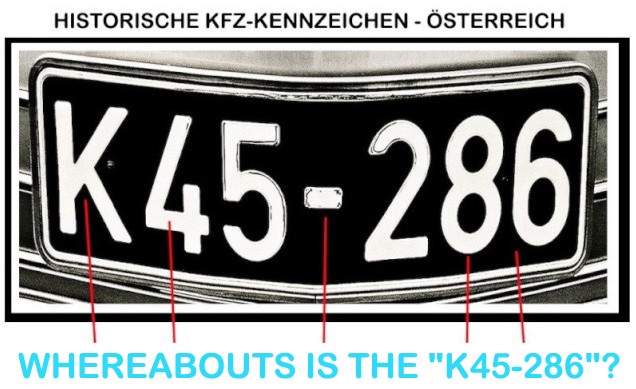 To my friend Mário Barroso and Sixto Suñe (the man behind this wonderful translation as the original text was written in Portuguese language)*
To my friend Mário Barroso and Sixto Suñe (the man behind this wonderful translation as the original text was written in Portuguese language)*
We’re mistaken. Zuffenhausen is right next door. Quarta-feira, 13 de Agosto de 2008 WHEREABOUTS IS THE "K45-286"?
1. INTRODUCTION.
Porsche Doppelkupplung (PDK) is the buzzword word these days. The double clutch gearbox is something that stimulates discussion. Or not. What I’m proposing here is a slightly different trip, a more distant one. A trip to what Porsche, AG once wrote on a large wall at the museum: Die Anfänge. The Beginning. It’s absolutely astonishing to witness the sheer quantity of information available today about the Triassic period. I’m saying it’s absolutely astonishing because the Triassic period happened some 225 million years ago. And 225 million years are a lot of years. It’s a very long time. You can’t count them with your fingers. I’m not at all impressed by the life of the Arcosaurs. What impresses me is that we, today, possess such a complete set of knowledge about the life of the Arcosaurs. Either someone is taking us all for a ride, or Man’s keen ability to dig into facts is much greater than can be imagined. Think about it: No one remains from that period 225 million years ago, able to tell us about the life of the Arcosaurs. No one could possibly have. At the time, there wasn’t even a project of a monkey. The first prototypes of dumb men-like primates appeared only much, much, much later. Still though, to my amazement, the level of knowledge we possess today about that period is such that it justifies entire lectures and courses at major Universities, it justifies the creation of Museums and all sorts of items such as books, movies and who knows what else. And the example of the dinosaurs is being used here by mere chance; we could refer to many other periods in History. The example of the Dinosaurs is invoked simply due to being a “heavy argument”, and, of course, a funny one at that. Instead of Dinos, we could be talking about Ancient Egypt, and our admiration and sheer awe would be just the same. It would be equally disturbing to find out that we today, as a clear evidential fact, are able to know details about Ramses II’s sexual life, and even oddities about his character, such as how much he enjoyed dipping his calluses in the Nile, before resorting to shave them while laying spread between two nynphettes. Even though this image may not be as ancient as those figures with large teeth, it nonetheless dates back to 3.200 B.C. (Before Christ) or 5.248 B.P. (Before Porsche). Which is also a very long time. If on the one hand I’m intrigued by this stratospheric dimension of such deep levels of knowledge, on the other hand I’m equally intrigued when exactly the opposite occurs. Scant levels of knowledge. The difficulty of coming up with concrete facts. Which brings me, logically, to PORSCHE. And I promise I won’t mention Arcosaurs again. Otherwise I may come to the point of questioning my own existence. Or the existence of Porsche, for that matter. To use one of my first phrases from above, it’s “absolutely astonishing” to see how Porsche’s History is so obscure and complex. It’s amazing. To start with because Porsche’s History is still being written. It’s being Written by us all, every day. It is past, but also part of the present. We, the customers, lovers and followers of the marquee – interfere. It’s not improper to say that we make up part of Porsche’s History. When we spend our economies buying Porsche, we’re contributing and participating in Porsche’s History. Our contribution goes in the company’s accounts. It will serve to pay workers wages, it will serve to develop the future nine-whatever. Forget then whatever was said about unmemorable times or ancestors that lived before the Big Bang or what not. Porsche remounts to 1948. Which is laughable, because, if I’m not mistaken, 1948 happened just last week. Or two weeks ago, I’m not sure. I don’t want to be incorrect on this. It’s ridiculous. God have mercy on our dear Professor and his son, but almost everyone else ever related to Porsche is still alive today. 1948 happened last week. This amazing and glorious week went by in a flash, but it’s here, and still fresh ! The actors are still roaming and breathing among us. As are also among us all the milestones that occurred during these two long and exhausting weeks. Porsche’s History resembles that of a man in his sixties with a bad case of amnesia. However, in Porsche’s case, there is no justification for so much mystery. Except maybe for the preservation of politically correct versions that are so dear to the Corporate Marketing departments of modern times. In my experience with Porsche, I learned to discover the facts by inversing logic. I learnt starting from the end. From the consumed fact. I would then rewind the tape and look for clues that could indicate other paths. The methodology is fascinating, since it transforms us into a sort of Sherlock Holmes, ready to deconstruct the thesis of the homicide committed by the pre-condemned butler. Enthralled in this transcendental mystique of cosmic obscurity around our marquee, I resolved to share something that’s been bothering me for many years. Something that – as the saying goes – makes me uneasy (whatever that means). I’m not writing this for the sake of having an opposing point of view. Nor am I writing this in the hope of being controversial. However, I feel an irresistible urge to say I suspect that the first Porsche, THE ALLMIGHTLY MYTHICAL UNTOUCHABLE IN ALL OF PORSCHE’S HISTORY – THE NUMBER ONE – is not what Porsche says it is. It is a Replica !! Figuratively Speaking, of Course ;-)
Photo 1: The “K45-286” in it’s Porsche Official photo (werk photo):

So there. I’ve let it out. I’ve been sarcastic. I’ll now proceed to being more rational. Thus I’ll lay down yet another theory: The number 1 Porsche, the one that Porsche exposes in its museum, the famous “K45-286”, may not be the famous prototype of the 356. Or then it may. Or not. Or it may be. Or maybe not. Or ma-not. My doubt is perfectly legitimate as I shall explain. To be sincere, I’d feel a lot better if I had reached the conclusion or if I were to admit that the car in question is really not the first Porsche, but rather something else. The exercise I propose here is to discover what this car is. And what it will need to preserve from its past, to remain original. If the number one is indeed real, the current “K45-286” is a tad outrageous for Porsche Lovers. And don’t blame me for it. This car is about to become the piéce de resistance at Porsche’s new Museum. It will be the museum’s greatest billboard. It will be the most prominent object at the new Porsche Museum. It will be displayed in public like no other Porsche. It will have more spotlights aimed at it than all 917’s combined and than all the companies that gained all of the greatest sporting conquests for the marquee. But does it deserve it?
Photo 2: The Prototype as it is presented to us by Porsche today:

Photo 3:

One thing is for certain; this car, the “K45-286” has nothing in common with the original “K45-286”. When I say nothing, I mean practically nothing. Which is bewildering, to say the least. A popular saying goes: “whatever has been built once, can always be built again”. This is a great truth. If in 1948 Ferry Porsche managed to build the number 1 prototype in Gmünd with barely any resources at his disposal, it should be a walk in the park to build an identical one today, given Porsche’s millionaire assets and resources. Logical, isn’t it? As much as I may be tempted to do so, however, I will not follow this line of reasoning. For now, I will admit to the truth as presented by Porsche: i.e. the fact that this is effectively the Porsche prototype number 1. We shall see. In order to find out if this is a misplaced theory, we’ll need to hop on to our time-machine and travel back to 1948… to Porsche’s place of birth: Austria.
2. WILKOMEN ÖSTERREICH: THE PORSCHE FAMILY FROM THE ALPS.
Most people associate Porsche with Germany. Which in itself is not incorrect. But the Porsche family is not exactly from Germany. Ferdinand Porsche was born in Maffersdorf, in the Northern Bohemia, which at the time was part of the Austro-Hungarian Empire. Today part of the Checz Republic. A land where German is the mother tongue, naturally. Historically, the Porsche family has kept its ties to Austria. More precisely to the Village of Kitzbuhel in the area of Kitzsteinhorn in Zell am See. The region is infinitely and indescribably gorgeous. My Macho Latino status, however, doesn’t allow me to use such relatively gay superlative adjectives of etiology, to characterize the natural beauty of that particular region of our Planet. I’ll place a few photos down the line to better grasp the concept. The Porsche family’s ancestral home at Zell am See is a typical Hof Schüttgut, similar to those houses that appear in the Heidi story books, or in those “odd” old movies shown on the RTL channel. The house, known today as “Porsche Villa” (as is the case with all houses belonging to the Porsches), was built in 1942 by Josef Becvar an Architect from Vienna. The project was named “Porsche Haus”. The region is known as “Porschegrund” (Porsche-Land). Next to the “Porsche Villa” we can now find a Hotel that once belonged to the Porsche family: the “Porschehof Hotel”. The area is marked as private, and the private road leading to it, warns of the fact that the property belongs to the Porsche family. The view into the houses is excellent, and lodging at the Hotel is only possible by previous appointment. The site is definitely a “must” destination for the more hardcore Porschefiles. The family tries to preserve the “Porschegrund” as best and as discreetly as possible, for a very simple reason. Adjacent to the house, a small white chapel was erected, licensed as a private Cemetery. It serves as the final resting place for Professor Ferdinand Porsche and his children, Louise and Ferry Porsche.There’s an additional bastion of the Porsche group at Zell am See: The Headquarters of Porsche Design, created by Butzi Porsche. Home to Porsche Design, to Porsche Design Driver’s Selection and to the Porsche Design Studio.
Photo 1: The village of Kitzbuhel:

Photo 2: Panoramic view of Kitzsteinhorn:

Photo 3: The Porsche “Villa”:

Photo 4: The “Porsche Haus” project:

Photo 5: To the left we can see the entrance to the “Porschegrund” property. To the right we can see a meeting of Porsche Diesel tractor owners, with their vehicles parked in front ot the house:

Photo 6: The “Porschehof” Hotel:

Photo 7: The little white Chapel next to the “Porsche Villa”, where members of the Porsche family are buried. To the right we can see a group of Porsche admirers in an organized visit to the tomb:

Photo 8: The Porsche tomb:

3. THE GMUND SAWMILL – BIRTHPLACE TO THE “K45-286”.

The wooden barracks at Gmünd are part of the imagination of any Porschefile. They represent to Porsche what the nativity cave in Jerusalem represents to Catholicism. Fifty workers lived and worked in these barracks, enclaved in the midst of mountains with freezing temperatures, hidden from the enemy and camouflaged in old sawmills. Parts would arrive by train, then received more than 15Km’s away, a distance covered in an enormous effort. Some of the mechanics spent more time among cows than they did among their colleagues, since the premises were often shared with these animals. Many years would pass until one day Ferry Porsche would publically admit the following: “It was a miracle to have built an automobile (read: 50) at Gmünd”. Leaving the barracks will find Salzburg 160Km’s to one side, and Gmünd some 2Km’s to the other side. Gmünd was a small village. In its town square laid a giant scale, used by the villagers to weigh their cattle during auctions. Come May 1947, something fantastic would occur at the village. School would stop and children would run to the village square. Seemingly out of nowhere, an incredible vehicle would appear: its structure stripped of a body shell. It was the 1st prototype, which would frequently travel to the public scale to be weighed. It was the perfect way Porsche engineers found to control the work and development performed on the prototype.
Photo 2: One of the first 356 coupes (in this case the “K49-801) being weighed at downtown Gmünd, surrounded by Villagers:
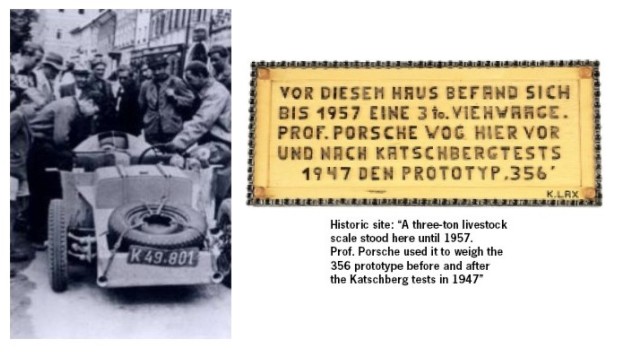
3.1. THE GMUND ALUMINIUM.
The story of the Gmünd Porsches is out of this World. It’s almost paranormal. The very first Porsches were to be built using a full aluminum body shell. Despite being the earth’s crust’s most abundant metal, aluminum was not available in Austria at the time. Therefore it’s important to clarify that the Gmünd aluminum was in fact Duraluminium sourced from Switzerland. Its light weight and low fusion point provided it with flexibility for a multitude of applications, especially in aerospace engineering (which Ferdinand Porsche was so fond of) and of course, to car manufacturing. For the Porsches, low weight was the best way to guarantee good performances. It was also the cheapest solution. Additionally, it was easy to work on and gray in color. It was the only color capable of transmitting the silver arrow ideology so dear to the Nazi regime. For those who may be unaware, it servers to explain that all 356’s produced at Gmünd, entirely bodied in aluminum, are the rarest and most valuable of Porsches. The Auto Union cars done by Ferdinand Porsche were all flown to Russia and are impossible to purchase. Although I would risk stating that it is equally impossible to find any of the nearly 50 (49 + 1, or more, 52, 60, 62, depending on the version – which we won’t get into discussing here) aluminum 356’s with the “split windscreen”. It took the last proprietor known to have restored one (an Englishman, Delwyn Mallet) 28 years to do so! The Gmünd body shells suffered from abnormally high levels of rust. It even led Mallet to gracefully state: “the rust was so much, that even the rust had accumulated rust”. The restoration is depicted in a very witty article published by Mallet sarcastically entitled “Rust in Peace”. This phenomenon is a rather strange one, since resistance to corrosion and durability is one of aluminum’s most well-known qualities, due to the protecting layer of oxide. The fact remains that all the Gmünd 356’s gained rust. (I have seen photographs of almost all the Gmünd survivors). This makes them very special cars. These cars had additional peculiarities that make them unique. The entire aluminum bodywork gained it’s shaped by being hand-beaten with a mallet over a wooden mold.
Photo: An aluminium 356 next to its wooden mold, which can be seen in the fantastic museum at Gmünd, “Porsche Automuseum Helmut Pfeifhofer”:

Photo 2: The Aluminium body:

Photos 3 and Photo 4: My friend JOSÉ GUEDES - a reference for 356’s in Portugal (http://porsche356.blogspot.com/) - recently visited the museum and was kind enough to remember me and offer me the museum’s leaflet and admission ticket:
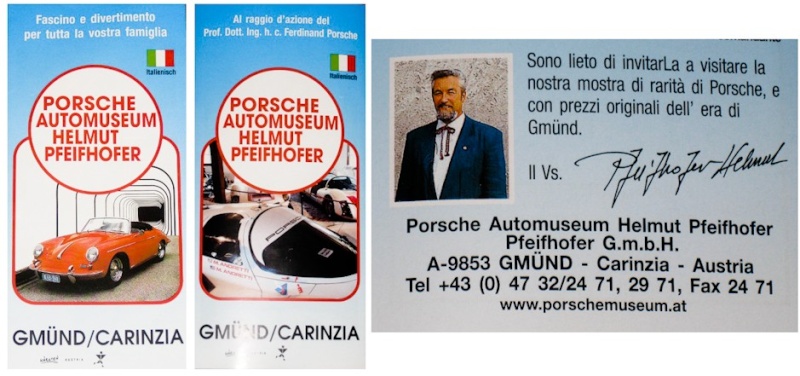
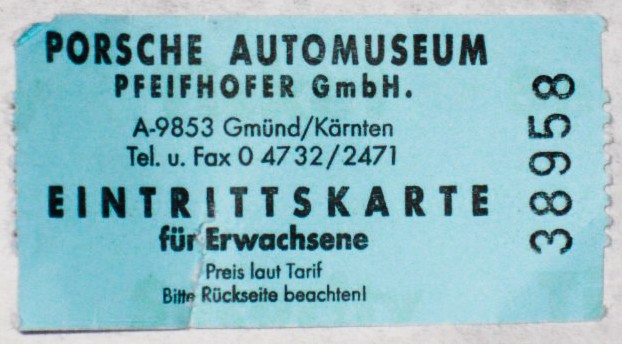
There were only 3 people capable of building the aluminum Porsches at the time. Two of them were very plane folk, the third man being the only real master: Karoseriebauer Friedrich Weber – an alcoholic who would induce production stops at the factory whenever he’d had a bit too much of the spirit. Ferdinand Porsche met this artisan while working for Austro Daimler. More than an artisan, Weber was an artist. Each one of the Gmünd cars came out different. For each one of them, Weber revealed a different inspiration. A different humor. Alcohol would constantly change his state of spirit (no pun intended). The greatest trait of the Gmünd 356’s is today pointed out by Porsche: it’s the fact that THERE ARE NO TWO CARS ALIKE. All of the Gmünd 356’s are in fact different. We can’t forget the fact that parts were very hard to source at the time, due to the war. The number 1 prototype itself was mostly made up of parts found in Kubelwagens destroyed during the war. The objective of the automobile industry was to build cars that would be equal. This, in wooden, Austrian barracks back in 1948, was an impossible mission for Porsche. Having rather rudimentary looks is yet another trait of the Gmünd cars. It is quite evident that these cars were the fruit of manual labor. There’s an abyssal difference when compared to the later 356’s. The bodies later built at Reutter, for example, are much more perfect than those made in Gmünd. However, the artisan-like quality of the aluminum 356’s provides them with a much more valuable and rarer status. It’s important to mention the fact that the aluminum bodies served no structural function in the cars. These cars possess a further characteristic that distinguishes them from all others. They don’t have a single sharp edge. They are completely rounded and undulated. The Gmünd mold would make it impossible to produce an angle. Curiously, this would forever determine the characteristical shape of all Porsches to come. Mainly that of one particular model that would derive from the 356 family; the 911.
Photo 5: A very rare photo of the Gmünd workers with their finished work of art (Porsche.com site):

Photo 6: A no less rare image of Friedrich Weber working at the Gmünd barracks:

4. THE TYPE 356. THE NO. 1 PROTOTYPE. THE NO. 1 PORSCHE. THE “K45-286”.
The first official Porsche is known today as the “K45-286”, named after its first registration plate. Porsche was keen on immortalizing this car as part of its History. It did everything possible to shift attention from the pre-1948 racing prototypes, the K60 Type 64; the only surviving example of which belongs to Otto Mathé. As we know, it was Ferry Porsche himself who placed the “Porsche” lettering on the car he sold to his (then) dearest customer. Otto Mathé was also the first owner of the “K45-297” previously registered as “K63-221”. Prototype #1 was the first car to boast the “PORSCHE” name in its bodywork. Of course there’s quite a heated difference of opinions between the Porsche family and the Mathé family, since the latter’s 60k10 bears the PORSCHE letters in front (which, as far as logic would have it, isn’t Mathé’s fault, since it was Ferry Porsche himself who put them there). Porsche 356 Historian Laurence Meredith, (author of “Original Porsche 356”) goes (in my opinion) too far when in his book he writes that the Berlin Roma car was the first Porsche to bear the name. However, the first car reputed by Porsche to be the manufacturer’s first official car is the 356 Roadster prototype. It was also the only roadster out of all the Gmünd cars. The other cars built at this location were mostly Coupés, save for a small number of cabriolets. This was due to the fact that in 1949 (a few months after having built the prototype) Porsche ordered a market survey that showed consumers were not likely to be interested in 2-seater open-top cars. This was the reason why the number 1 prototype never made it to production. On June 11th, 1947, Erwin Komenda was responsible for starting the drawings for the Type 356 project, which Komenda would finish a month later, on July 17th, 1947. Karl Frolich was the specialist responsible for the gearbox and suspension, who would also play a determinant role in the first car. Josef Kales and Josef Zahradnick, Josef Mickl, Wilhelm Hild, Karl Rabe and Franz Xaver Reimspiess made up the core team for the prototype’s construction. The prototype’s chassis would only receive a body, however, on April of the following year. Thus, Gmünd’s chassis number. 356-001 and engine number. 356-2-034969 were born. On June 8th, 1948, the Government of the Austrian lower stated of Carinthia, issued a special authorization for the homologation of the Gmünd prototype. This homologation is recorder in the magnificent document entitled “Einzelgenehmigung Bescheid”, Porsche Konstruktionen Ges. m.b.H. Gmünd, Karten, Ref. 28-30/48 n.º 4328 Porsche Sport Prototype 356/1. The engine was a Volkswagenwerke Fallersleben, with a tubular chassis, a VW axle and semi-axle, its engine displaced 1.131 cc, had 4 cylinders and put out 40 hp at 4.000 rpm. The fact it was Sport Prototype meant that the number 1 356 n.º 1 had a 40 % performance gain when compared to a normal Volkswagen. Top speed was 140 km/h which was considered excellent. What Porsche did then to the small VW engine is comparable to what tuners do today to Porsche engines. In stock form, the VW engine produced a mere 22 hp. Hemispheric combustion chambers and admission valves were applied, a totally redesigned exhaust, double carburetors, and the compression ratio increased to 6.5.1 (the highest possible achievable with the 78 octane gasoline available at the time). The layout was mid-engine, (the only one produced Gmünd) although that terminology was not used at the time.
Photo: Drawings of the 356 prototype crafted by Komenda in 1947:

Photo 2: The first “ID Document” of a Porsche vehicle:

Photo 3: A few members of the Gmünd “dream team”:

Photo 4: Rudolf Rühr at the wheel:
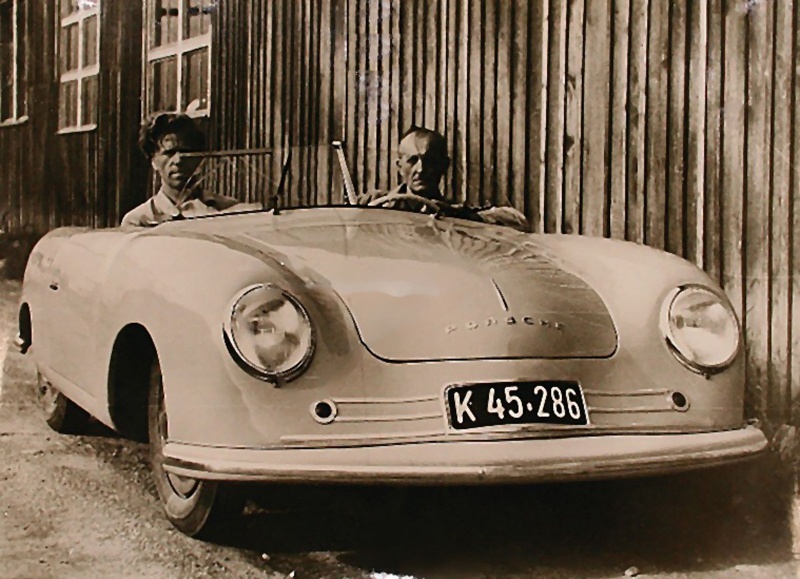
Photo 5: the number 1 in the yard:

Photo 6: The “k45-286” at it’s birth place: Gmund:

Photo 7: Probably the most emblematic prototype’s photo of all times; beautiful:

My friend and Porsche History Guru, ARMANDO CEIA, sent me these spectacular reproductions of the prototype’s original document.
Photo:

Photo 2:
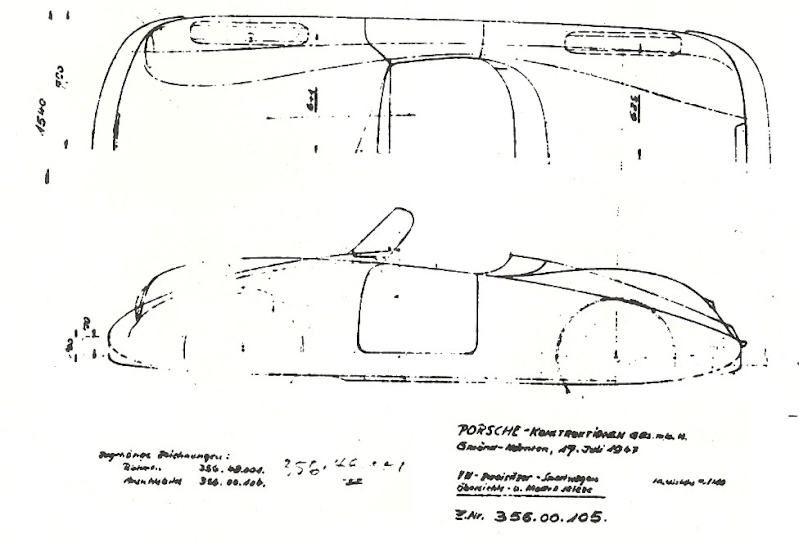
Photo 3:



Photo 6: The tubular Chassis design:

Photo 7:
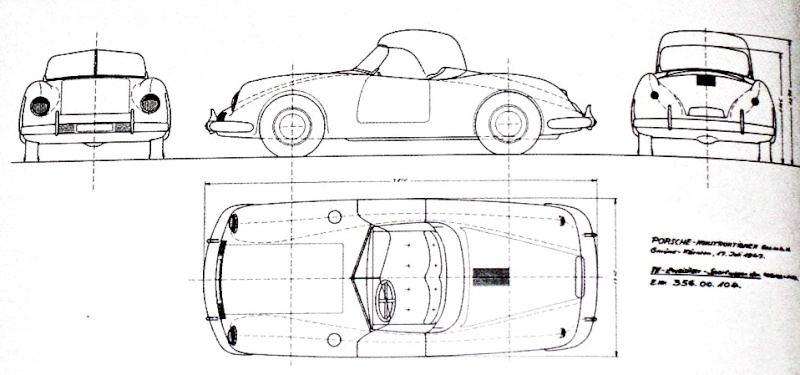
Photo 8:

Photo 9:
Photo 10: The very first Porsche "Werkfoto". Two pictures taken behind a wooden shed to be part of the registration process. There is another historical date to remember: 15/06/1948 - k45-286 official registration confirmation. 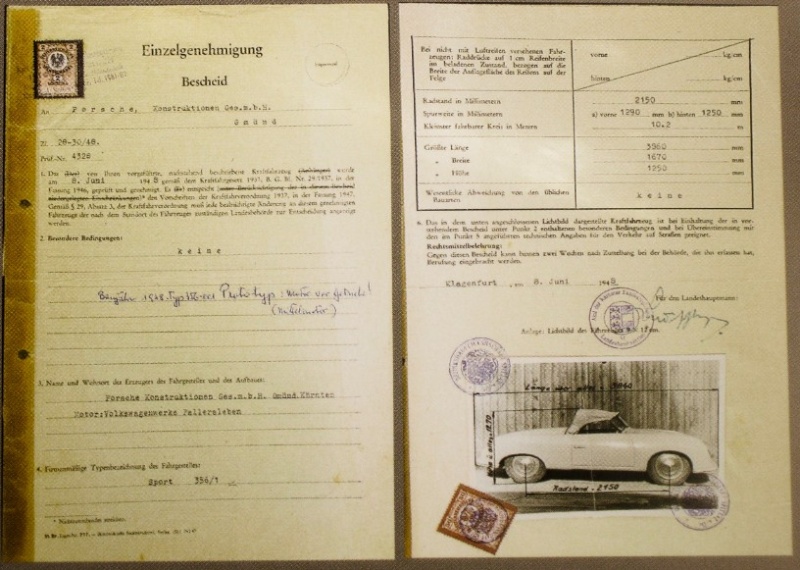
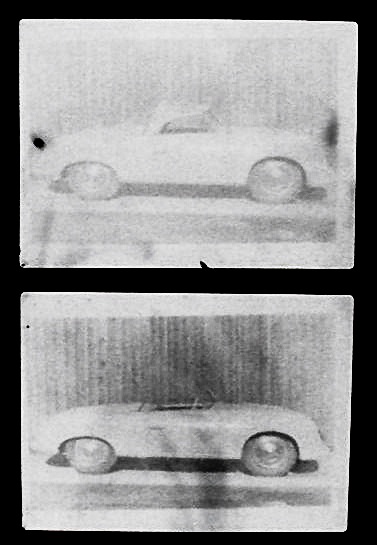
5. “IN YOU LORD I TRUST” - THE “K45-286” TEST DRIVE. HIGH EMOTIONS IN THE ALPS.
The first 6 months of 1948 proved to be an unforgettable time in Porsche’s History. Ferry Porsche needed someone to assist him with the road test sessions of the number 1 prototype; he would choose Robert Eberan von Eberhorst, an expert in the field. Eberhorst had been an engineer at Auto Union (specialists in beating records) and possessed a deep knowledge of the complexities that made up race cars. He arrived from Turin, where he was deeply involved in the construction of Piero Dusio’s Type 360 Cisitalia Grand Prix; a very famous project from the Porsche Design offices, whose entire proceedings would serve to pay for Ferdinand Porsche’s bail to the French authorities (one million Francs). Tests for the number 1 were divided into 2 series. Naked chassis with no bodywork, then with chassis + bodywork. They took place in the world’s wildest public test-track: the Alps. The first tests took place in Katschbergpass, the later ones being in Grossglockner Hochalpenstrasse. Grossglockner is Austria’s highest mountain, almost 4.000 metres high. Of all the Alps, it is only surpassed in height by Montblanc. It is located between Carinthia and the Tirol, and possesses some truly winding roads that demand sharp driving skills. The Grossglockner road is an Engineering masterpiece, created by the genius of Franz Wallack. It is arguably the most fascinating driving circuit available to man. The road was mathematically traced with a 3 to 5 metre width, and built in such a manner that its different stages would be visible by the driver from a distance. To get a grasp of Grossglockner’s dimension, its cost in 1936 was calculated at 53 million Euros, in today’s money. At the start of the mountain climb, laid a lovely stone portico, where the following inscription could be read: “In te, Domine, speravi” which means “In you, Lord, I trust”. This was Pope Benedict XV’s motto, a passage taken from a salm in the Bible. The Katschberg pass between Carinthia and Salzburg, also proved to be a preferred test track, located at a lower altitude of 1.700 metres. The sandbags placed in the car’s chassis to simulate weight also became famous. Katschberg was much more accessible (thus its usefulness while the car was being finished) and made up an excellent “Ramp”. It had a 10km climb to the top, then a longer downhill ride to St. Michael in Lungau. All in all, heading north, from Gmünd to St. Michael the total distance was about 50 km. This was an ideal course to test the 356.
In 2007 Karl Rabe’s son, Dr. Heinz Rabe (himself godson to Ferdinand Porsche), today 75 years old, upon request from the Porsche Historical Archive, has dedicated his retirement to translate his Father’s diaries. Dr. Rabe commutes daily to the archives in Zuffenhausen to proceed with the ongoing translation of the intricate diaries. These were found by chance, misplaced inside a chest in the attic of the old Rabe state in Korntal. The diaries are all written in Sütterlin (the ancient German blackletter handrwiting) which was officially lectured in German schools from 1915 to 1941. A good part of Porsche’s history is handwritten in the ancient handwriting. Only recently a previously unknown date was revealed in Porsche’s History: June 6, 1948: the day in which the number 1 prototype stepped on the road at Gmünd to be driven for the first time. Rabe's work was keenly "recruited" by Porsche's Historical Archive - Historisches Archiv der Porsche AG located at Schützenbühlstraße 8670435 Porscheplatz 1 70435 Stuttgart-Zuffenhausen (WERK 3) and will soon be accomodated in a new luxury home; the New Porsche Museum. This move is not only necessary, it is also fully deserved, since Dieter Landenberger, the young historian and writer that replaced Klaus Parr in 2005 as head of Porsche's Historical archives, has managed to instill a breath of fresh air to Porsche's History, transposing it to a dimension of importance yet to be seen.
Ferry Porsche and Engineer Rupilius crossed the Moll River and headed for the road to Zell Am See – the first trip.
Photo: Grossglockner:

Photo 2:

Photo 3:

Photo 4:

Photo 5: the first markings in the mountains started in 1929. A high-risk job that required Alpine mountain climbers. 1930 then saw the first explosions with dynamite:

Photo 6: The day of the great inauguration under the portico with the inscription: “In te, Domine, speravi”!

Photo 7: Porsche lovers regularly organize Grossglockner runs to present day in memory of the Porsche geniuses:

Photo 8: For the more fanatical, there’s of course crossing the Grossglockner by tractor:

Photo 9: The magic triangle of Zell am See – Grossglockner - Gmünd:

Photo 10: test drive at the Katschberg with funny helmets on:
 6. THE “NEW AUSTRIAN VOLKSWAGEN” AND PORSCHE’S FIRST VICTORY.
6. THE “NEW AUSTRIAN VOLKSWAGEN” AND PORSCHE’S FIRST VICTORY.
The first public presentation of the “K45-286” took place on July 4th 1948 – by occasion of the Swiss Grand Prix in Bern. It was Porsche’s first press conference and presentation. The respected Swiss automobile magazine “Automobil Revue” performed the first test drive. The results couldn’t be better and the prototype received nothing but praise. Robert Braunscheweig, the magazine’s editor, concluded: “this is the sort of performance we foresee for modern cars”. Brilliant. An additional curious fact: For the first time, the number 1 prototype was depicted on a magazine cover, more precisely on the # 24 issue of “Wiener Ilustrierte”, on August 21st, 1948. The caption read in bold letters: “DER NEUE OSTERREICHISCHE VOLKSWAGEN” (the new Austrian Volkswagen). After this, came the glorious day of July 11th 1948, the day in which Porsche won its first race. With the “K45-286”, of course! The new track favourite. Herbert Kaes was the Pilot; he was Ferdinand Porsche’s nephew from his Wife Louise Kaes’s side, therefore, cousin to Ferry Porsche. The event was the “Innsbruck City Race“ referred to in Austria as the “Rund um den Hofgarten”. The victory was in its class, but raised everyone’s attention. Herbert Kaes simply arrived with his Porsche and won. This was a very important landmark in Porsche’s history. The same can be said for the pilot-engineer, who would keep his ties to the Company all the way to 1978.
Photo: The Wiener Ilustrierte from August 21st, 1948:

Photo 2: The prototype in an ad from 1985:

Photo 3:
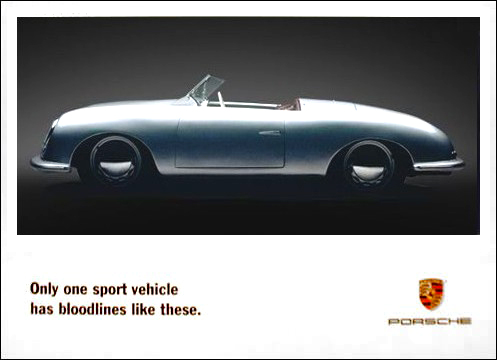
Photo 4:
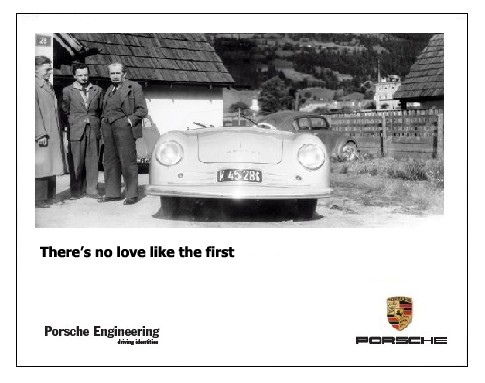
Photo: 5: The car in an official Porsche pub film:
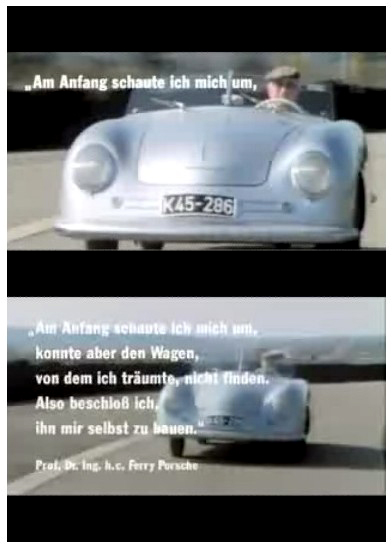
Photo 6: An Insurance Ad:
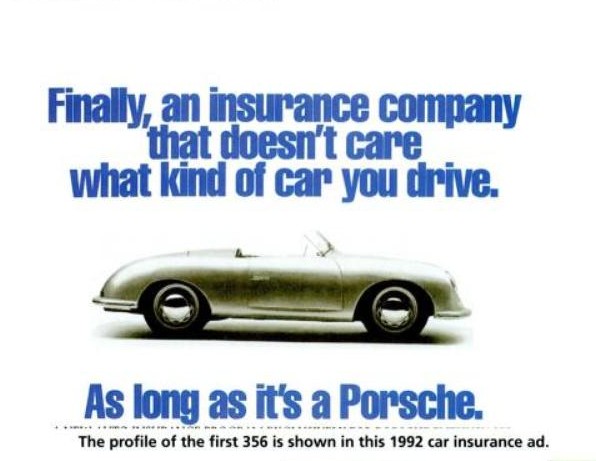
Photo 7: Piper Edition book issued for the opening of the new Porsche Museum:
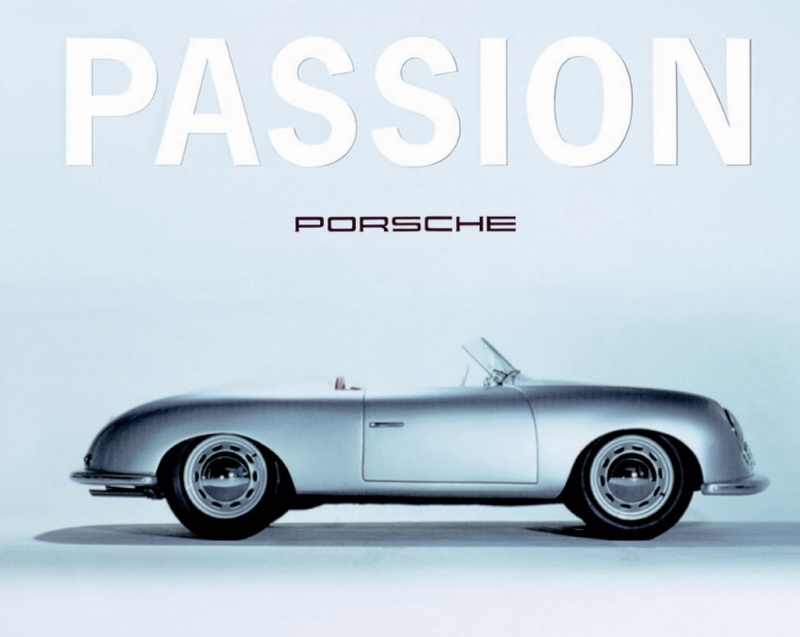
Photo 8: Official Pub campaign named "I can" (October 2008):

Photo 9: 2008 60th Anniversary brochure:

Photo 10:
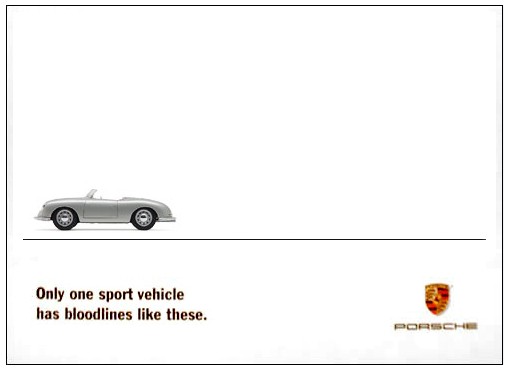
7. THE MISTERIOUS RUPPRECHT VON SENGER AND BLANK’S MONEY.
Switzerland! We all know that Germany is Porsche’s land by excellence. But it wasn’t always so. In war ridden times, when the Porsche family took refuge in Austria, Porsche’s centre of gravity leaned between Austria and Switzerland. The latter was a European paradise. Unaffected by war, it was the place where all Europeans kept their money (the Nazis included, of course). In January 1948, a happy event in the life of the Porsche family occurred. Heirich Nordhoff, former Director at Opel and close friend to Ferdinand Porsche, assumed command of Volkswagen. Perfect. September of that year would see Porsche being appointed responsible for all projects at VW. A fabulous deal would be struck, that yielded Porsche 5 DM in Royalties, for every single VW built. The best, though, was yet to come; the deal that allowed Porsche to leverage Volkswagen’s entire distribution, sales, and technical assistance network for its own vehicles sales and service. Rupprecht von Senger has umbilical ties to Porsche’s history. He’s a central and essential figure to the Porsche Company start-up. His name shall forever be related to the make, regardless of how much Porsche may wish not to remember. Rupprecht von Senger will also remain tied to “K45-286”’s tumultuous history. Rupprecht von Senger was a very intelligent man who always admired Ferdinand Porsche. He studied Architecture and during the war years worked as a drafstman at Oerlikon, Bührle & Cie.. Later he undertook it on his own to build a 4-seater car. The year was 1946, when he would seek Ferdinand Porsche for the first time, whom he would entrust with his project. A project that would be known as the Type 352, for which there would be no production. Von Senger soon understood that Porsche was a winning horse. A horse on which all bets should be placed. He was the first to do so, before us all. And for that, he would have deserved more recognition. He was Porsche’s first customer. And that’s a serious status. A sharp-spirited Swiss entrepreneur, Rupprecht von Senger, headed for Gmünd as soon as he learnt of Porsche’s moves there. He would become the great private investor who would sponsor the Company’s first steps. Fascinated with Porsche’s grand start-up, Rupprecht von Senger showed up on September 1948 to take with him prototype number 1. Which makes him the first owner of a Porsche in History, an undeniable fact. And he owned the“K45-286” to boot. Total price paid was 7.000 Swiss Francs. He would in turn make a profit of 500 Swiss Francs, by reselling it to a fellow countryman. Von Senger would also purchase all the remaining cabrios (without seeing them) and take them to Switzerland. He purchased chassis 356/2-001, engine 356-6- 020199 (coupé prototype); chassis 356/2-002, engine 356-6- 021343; chassis 356/2-003, engine 356-6- 014106; chassis 356/2-004, engine 356-6- 014109 and chassis 356/2-008, engine 356-1- 000010. The deal was closed with help from Anton Piech, brother-in-law to Ferry Porsche. The money for the transactions actually came from a great friend; Bernhard Blank, a very wealthy man. At the time, Ferry Porsche was so grateful to von Senger that he would name him as Porsche’s #1 official representative. His megalomania and fascination for Porsche, would decidedly disturb Rupprecht von Senger’s life. He committed himself to purchasing 50 cars – a challenge he’d prove unable to surpass and which would lead him to ruin. When I read Ferry Porsche autobiography, I became rather intrigued by the manner in which he referred to von Senger. When referring to his name, he used “a” instead of “the”, as if giving the notion he didn’t know the man all that well. Furthermore, Ferry Porsche refers to Bernhard Blank (the source of Senger’s money – the first “live” cash ever to enter into Porsche’s account) as if the latter two were unrelated, and claimed that it was Blank who came to negotiations with Porsche, by way of being an acquaintance of the Family. This in fact was not how things went down. Von Senger challenged Bernhard Blank to invest in a young automobile manufacturer. Blank owned an inn called “Seefeld", located in at Dufourstrasse 4 in Zurich. He was also a car dealer, representing makes like Tucker (yes, as in the famous movie). Von Senger convinces Blank that Porsche could go very far. He reveals the mystique and genius of Ferdinand Porsche to his investor, and together, think about ways to reach return on investment on a sports car company. The found a simple formula: Branching out the Porsche brand. One of the greatest contracts in Porsche’s history is drawn. The Austrian Government demanded the exporting of the vehicles as a condition to import parts. This was achieved with Switzerland, where access to Volkswagen was easy. Von Senger was responsible for the supply of the Swiss aluminium. The merit for the aluminium reaching Gmünd is his. This partnership would remain in activity until 1951. Officially, Porsche’s production started on February 28th 1948. Still in the same year, other Porsches would see the light of day. As is the case with the #2 convertible, the equally famous “K49-804”. The first car out of Porsche’s first production run, would be completed 2 months after its construction started, going straight to Switzerland, to be shown at the Geneva Auto Show. The bad blood that sprouted in the “Senger-Porsche-Blank” triangle is owed to the fact that von Senger deluded Porsche as to the origins of the money being invested. The grapes went sour one day on August 1948, when Blank accidentally came across Senger, accompanied by an unknown man wearing a tyrolean outfit, at the Bahnhofstrasse in Zurich, Switzerland’s main financial street. Blank stopped to have a word with Senger who, strangely and inexplicably, throughout the length of their encounter never introduced Blank to the man he was with; Anton Piëch, lawyer and brother-in-law to Ferry Porsche, the person receiving the money from Blank. Blank showed two cars on that Geneva Auto Show in March 1949 that would awaken curiosity from AMAG, Volkswagen’s Swiss representative. This Auto show would also see the first customers for Porsche cars. One of them, who became unconditionally surrendered, was Prince Mohamed Abdel Moneim, son of Khédive Abbas II, Crown Prince of Egypt. Blank sold the #3 Porsche (356/003 chassis 003 from 1948, but bodied in 1949) a “bordeaux” cabrio, as well as a coupé… to Egypt! Where he quickly acquired an additional customer. A year later, a 356 would be sold to His Excelency Mohamed Taher Pasha, of Cairo. In financial terms, the Gmünd venture was a failure. It would hardly ever work out, since it was riddled with short-handed conditions. The solution ended up in resorting to independent companies in the automobile sector. As soon as this reality was perceived, Porsche celebrated contracts with third parties to build its cars. It did this with Keibl in the Landstrabe, district, near Vienna, in Austria; as it did with Tatra, in the Simmering district (also nearby Vienna, Austria); with Kastenhofer in the District of Margareten and with Beutler in Thun, near Bern, in Switzerland. All of these factories were provided with Erwin Komenda’s drawings, along with almost all the parts necessary to build the 356. This outsourcing of Porsche’s production had a perverse effect. It forced Erwin Komenda and the Porsches themselves to constantly travel to all the different production locations, to ensure that all the assembled cars remained faithful to the original design. Dirk Michael Conradt, a world authority on 356’s, tells a funny story about one such visit. Professor Ferdinand and Komenda are riding with Beutler to his installations, to see how work was progressing, during Beutler’s first build. The Swiss man was a snail at the wheel, and the Professor, already of an advanced age, started to get irritated. At a certain point in time he lost his patience, took Beutler off the wheel and started driving the car himself at quite a spirited pace. Later on, Beutler’s comment about Porsche would become famous: “he drives like a savage”. Aside from the number 1 prototype, there’s a car that also gained a particular history: the “K49-801”. That particular car, which very few people talk about, was a coupé, built at the same time as the number 1. Its Homologation registry dates from 1948. The Coupé, baptized in Gmünd as a “Sport Limousine” would be used by Ferry Porsche to be pictured in the sole Austrian prospect / catalogue produced at the time. It’s also important to refer the fact that this was Gmund’s chassis 356/2-010, engine 356-1-026857, coupé 557/5 that became known as the “K45-400”. It would become an official “show car” for the make. THE FIRST CUSTOMERS: Aside from those already mentioned, one can also name Count Ladislaus Almasy, Walter Marchtrenk, Martin Pichler, Gunther Pekarek, Dipl. Ing Gunther, Franz Walek, Goissern Aschauer, Meyer’s Heirs, Autohaus Liewers, Fritz Reisch, Dr. Ernst Henschel, Dr. Fritz Degerdon, Ing. Hruschka, Dr. Schindler, Dr. Muller, Dr. René Jager, Mautner Markhoff, Ing. Franz Friedwagner, Josef Muller, Autohaus Ebner and Otto Mathé. Susprisingly, one of the largest initial investors in the Porsche project was Scania Vabis, the famous Truck manufacturer from Södertälje, Sweden. Scania would purchase no less than 15 of the first 49 356’s produced by Porsche.
Photo: The “K49-801” Photographed in Gmünd with the number 1 prototype behind it:

Photo 2: Another Photograph of the “K49-801” - THE FIRST REAR ENGINE PORSCHE:

Photo 3: July 1948: Anton Piech and the “K49-801”- the 356/2
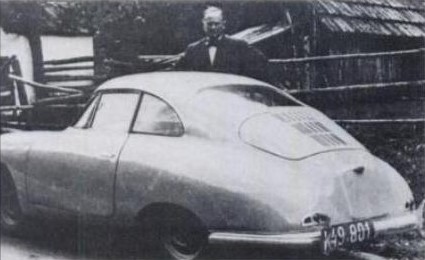
Photo 4: The number 2 convertible: “K49-804”:

Photo 5: The House Coupé; “Show car” “K45-400”:

Photo 6: August 1950, Herbert Kaes (the first Pilot to win a race with the first prototype) in Italy, with the “K45-400”:

Photo 7: O “K45-400” in a Photo Shoot:

Photo 8: The Geneva Auto Show of 1949. Notice Porsche’s first-ever publicity panel (reproduced on the side). The graphics are completely different than would be used in the future. This shows a rare style of the “Porsche” lettering, since it was laid out on an arch at first, being the product of Volkswagen Austria:

Photo 9: Blank’s Showroom, Photographed right after the Auto show in 1949:

Photo 10: Otto Huslein, Managing Director of the Gmund Works, driving the first prototype at the Gmund main entrance:
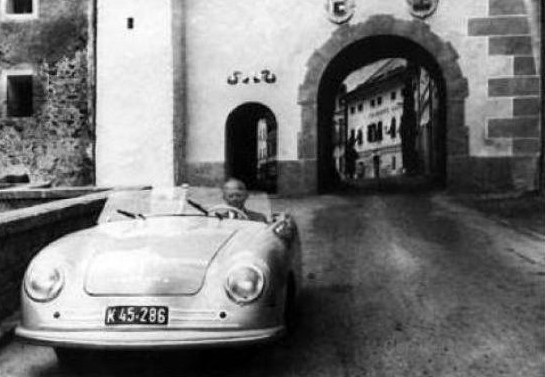
Photo 11: The “K45-286” in full enjoyment. Swiss roads in the 50’s.
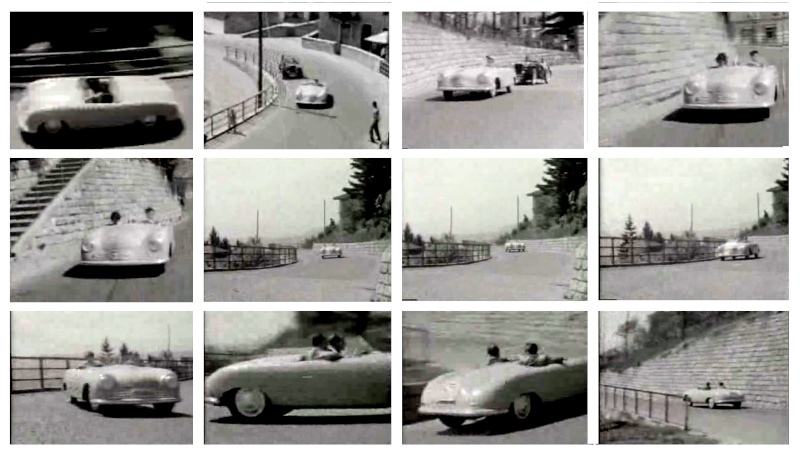
Photo 12: The Egyptian Crown Prince:

Photo 13:
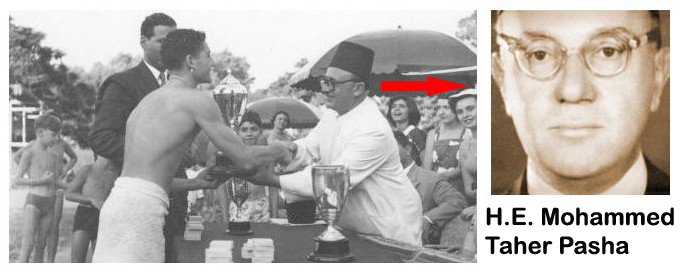
Photo 14: The Type 356’s posing next to a pyramid: 
Photo 15:

8. THE MISTERY OF THE CAR THAT SHOULDN’T EXIST.I’m opening a parenthesis here to tell a peculiar story. A few years ago, a mysterious car showed up at Hill & Vaughn in California (a specialist in refurbishing classics). To the amazement of the craftsmen working on the car, an aluminium body surfaced underneath the paint as the car was being stripped to the bare metal. The aluminium was identical to the material in the Gmünd cars. More intriguing was also the fact that the car very much resembled Porsche’s first prototype.
Despite being identified with the builder’s insignias “Hs. Waibel Carrosserie Zurich” (Switzerland), the suspicion arose about an untold story behind this car. A forbidden story. A hidden story. What would be the rumour that started to circulate? That this car would have been a prototype for the 1st Porsche, from 1948, probably built in 1947 !! First of all, there was no controlled production at Gmünd. Registering serial numbers on the main components of the cars, such as on the bodies and engines, would only become standard practice after the company’s return to Zuffenhausen, a procedure namely instituted by Reutter. The hunt for the “Waibel’s”” pedigree and origins was on. It would take its authors on a spiral of contradictions and fantastic discoveries.
All facts lead us to believe that in 1947, Ferry Porsche requested Ruprecht von Senger, through the President of Volkswagen Switzerland, DeBrunner, and through the importer Bernhard Blank, to commission the preparation of three prototypes to Hans Waibel; two of them to be shown at the Vienna Industry and Commerce Fair of 1948. Hans Waibel was recommended to Ferry Porsche by his ailing father, Ferdinand Porsche for whom he’d already build two prototypes in 1939. The biggest question that came up during the car’s discovery was to try to find out if that which no one else wanted to happen, actually happened. That is, to know if this car was built on a Volkswagen platform, or if it was already built on a Porsche platform. The core management team at Porsche shivered at the very thought of the 1st Porsche not having been the famous “K45-286” after all. In 1988, at the age of 75, Hans Waibel Sr. accepted for the first time ever, to give an interview in which the subject of the “ghost car” was brought up. According to him, the “waibel” was built in 1948 on a Volkswagen platform, in accordance with an adaptation of Erwin Komenda’s original drawings. Internally, the prototype was nicknamed the “VW Special Sport Cabriolet”. The car was improvised according to Waibel’s adaptation, where the usage of a frontal grill from a Morris Minor was highlighted. The car was also 27 cm longer than the 1st Porsche. Hans Waibel Jr. President of Waybel Werkes, AG, had also confirmed the fact that the prototype his Father had built had a VW chassis, but the Engine was Porsche. The serial number 1-085552 was found engraved in the engine compartment. The original engine was no longer there. Hans Jr., photographed the serial number and the car, and in 1986 sent a letter to Porsche, AG written to Herbert Linge in Weissach. Herbert Linge responded by way of a letter dated June 20th, 1968, as follows: “Unfortunately, I’m not able to tell You much about this. We are of the opinion that this car was prepared from a 356 (Porsche) chassis. There were several 356’s sold without bodywork ". This version was later confirmed by Karl Ludvigsen. On September 19th, 1988, however, B. Wiersch from Volkswagen AG’s headquarters in Wolfsburg, wrote to Hans Jr. informing him that serial number 1-085552 belonged to a VW, manufactured on October 8th, then sent to Switzerland on October 18th, 1948. Despite a certain lack of confidence about the exactitude of these “Oficially” presented dates, the fact is that Mr. Waibel Sr. admits he only started working on the third car at the end of October 1948. By that time, however, he had already produced the two prototypes for the Show. The car was sold to DeBrunner in 1953, who in turn sold it to von Senger. It then exchanged hands several times in Switzerland before ending up in the U.S. by way of Michael Rizzuto, then changing hands to Hollywood Producer Monty Montgomery. Starting in 1992, the firm of Robert Demars Ltd. undertook the task of unveiling the “Waibel’s” exact history, but not much more was uncovered since.
Photo: The fascinating “Waibel”. Then, during restoration, and in current times:
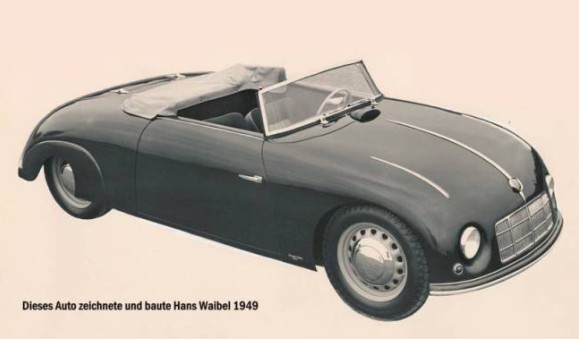
Photo 2:Photo 3:
Photo 4:
Photo 5:
Photo 6:
9. COME BACK OF THE “K45-286” ? THE GOOD SON RETURNS HOME.According to Porsche AG the number 1 prototype was initially sold, but later recovered by the manufacturer after 10 years. It meandered through many competitions, suffered server alterations, accidents, was torn to pieces, but made it back to Zuffenhausen where it was deeply restored to a shining state at the Porsche Museum. The car, according to Porsche, was sold to three subsequent Swiss customers after von Senger. It is known that the second owner used the car in a familiar manner, as opposed to the further owners who used the car for racing. As for the customers’ identities, Porsche seems to make it a point of being vague on this point. Or rather, it makes it a point not to mention the matter at all. Still, according to the official story, the “K45-286” went through intensive alterations. It lost its fender, was painted over several times, lost its engine (?) which ended up being replaced by more recent 1.500cm3 versions. It suffered accidents, having rolled over more than once. This entire afflicted period in the prototype’s life is inexplicably shrouded in a heavy mist. Porsche is adamant on merely pointing out the car’s first victory, achieved in Innsbruck on a distant July 11th, 1948. Why the rest of the competitive history surrounding the “K45-286” is erased from history, registries and mentions, is still a mystery yet to be explained. According to the official version, once the car was discovered, the Porsche Factory sent Richard von Frankenberg to negotiate the purchase of what remained of the mistreated “K45-286” with its owner at the time. It seems the deal ended up being an exchange. The factory offered a brand new 356 A Speedster in Exchange for the prototype. Personally I find such a deal unlikely. Regardless of the poor condition it might have been in, the value of the number one prototype would be incomparable to the price of a Speedster. The car would remain stashed away in a corner at Zuffenhausen until the construction of the museum.
There are precious few images that depict the “K45-286” in the vestments that characterized it during the period it was raced in. In this curious image, we can see the car shown in an exposition. The funny thing is that, in almost all of the sites allusive to Porsche that abound the internet, this photo is identified as being that of a Type 550 Spyder. The prototype is in fact unrecognizable; painted in white with four black tears, different seats, front striping missing, reinforced fixing points on the windshield, leather belts in front, etc. The front plate, though, tells the story:
Photo:
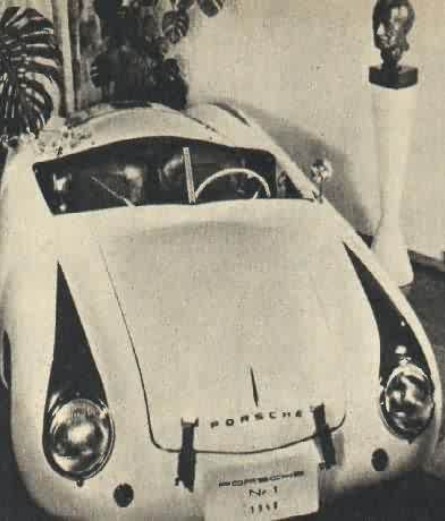
Photo 2: Another racing version, as it appears in the first Porsche Bible, the very rare book from Walter J. Spielberger “Porsche: the first decade 1949-1959”. Here the car appears with only the two front teardrops (longer than the earlier ones) and with a number painted on the hood:

Photo 3: A 356 A Speedster equal to the one that allegedly served to buy back the prototype:

10. THE TINKER’S MIRACLE AND THE RESTORATION NIGHTMARE.
Now here’s a “twist in the tale”. Carrying on with Porsche’s official thesis, a wild story is told by the factory in 1958, at the time the car was recovered: during the prototype’s first tests in Grossglöckner, tubular section on the front part of the chassis broke. The solution was an improvised repair in the middle of the mountains performed by a tinker. According to the “legend”, the Tinker soldered a “U” shaped reinforcement in “His own manner”, in such a way that the car could continue its journey. Well, in 1958, when Porsche first reacquired the number one, it affirms, incredibly, that the improvised reinforcement job performed by the tinker was still there! I can even admit this story to be true. However, two things seem odd. The first is that after a decade of having undergone heavy transformations for racing, such an improvised mend hadn’t been corrected. The second oddity is the need Porsche felt to reveal such a story. It revealed a preoccupation in trying to show everyone that there was no doubt this was the same original car. It seems to me somewhat of a forced story. Personally, I’d like to see some questions answered about this fact: 1- If the legendary U-shaped part was found on the prototype, was it kept or removed during the restoration process? 2- If it was removed, where is it? Shouldn’t it be on display at the museum? 3- Why are there no photographs of this mythical part? The “K45-286” went through a complex restoration process between 1983 and 1990. It took seven long years to bring back the car to its original configuration. This in itself is somewhat sinister. Frankly, it’s hard to swallow many of these things and I’m always amazed at the fact that no one has questioned some realities. In post-war Gmünd, a few men, working in barracks in the middle of cows, with practically no resources, were able to put together the car in a few months. After all those years, the almighty Porsche, AG, armed with the latest technology and with virtually unlimited resources, took 7 years to give shape to a car that, unfortunately, bears little resemblance to the number one prototype. Recently, the number one was placed in the hands of Hermann Ruettger (Autowerkstatt & Autohändle - Pleutersbacher Str. 30, 69412 in Eberbach), the world’s foremost authority in Porsche restorations. Hermann Ruettger’s “shipyard” is more important than Porsche’s own Porsche Classik division in Zuffenhausen. Ruettger is the biggest connoisseur of all the mythical and historical models from Porsche. Once he was asked whether he used to borrow tools from the Porsche Factory, to work on the older cars. He answered: “I don’t, but they sometimes come by my shop to borrow mine”. Hermann Ruettger laid hands on the number one prototype in 1998, after a terrible and stupid accident suffered by the car, during Porsche’s 50th anniversary celebration. The car was shipped to the U.S., to participate in two events, a show at Laguna Seca and on another event organized by the 356 Registry WCH of Monterey. While being unloaded from a plane at Chicago’s airport by a forklift, the car was dropped on the ground from a height, having suffered severe damage. It was immediately sent back to Germany, unable to take part in any celebration. This was a very sad and cursed way to celebrate a golden wedding anniversary. Don’t misinterpret me, Reuttger is a genius at restoring classic cars. The problem is that he’s a perfectionist, and thus the quality of the restoration can surpass the original work. The prototype was an ill-assembled car. It was imperfect. It even transmitted a sensation of being somewhat rudimentary. Which was precisely what was fascinating about that first Porsche. The first tests are never perfect. Even more so when they refer to a car built with precious little resources such as the ones that existed in Gmünd at the end of the 40’s. The “K45-286” that is presently on display at the Porsche Museum is too perfect. It provides a false impression of what the original must have been like. It lost part of its “cachet”. It lost some of the mystique from the imperfection of the Gmünd aluminum. The “K45-286” that today resides at the Porsche Museum isnt’ the same car put together by an alcoholic back then. I’d like to be able to look at the car and find asymmetries. Such is not possible today.
Photo: The fateful day of the accident at the Chicago airport:

Photo 2: The restoration in Zuffehausen:

Photo 3: The restoration at Autowerkstatt & Autohändle:

11. THE AESTHETIC CHARACTERISTICS OF THE N.º 1 PROTOTYPE:
1 – The car’s basic contours were of Nautical inspiration, as per the Porsche family’s great passion. The objective was to transmit similarities to a boat. The number one prototype was conceived to transmit the elegance of a “barchetta”. At the time, both in Germany (both Ferdinand and Ferry were members of the Yacht-Club von Deutschland), and in Austria, the great hobby and pastime of the Porsche family were boats. They owned boats of all kinds: rowboats, sailboats, motorboats. At that time alone they owned boats like the Kritcoh, the Burli, the Haus, the Putzi, the Antipi, the Sia III, etc.
2 – Simplicity in design, lightly influenced by Art Nouveau, with some inspiration from the "Jugendstil" German style, mainly with respect to details like the split windscreen, door locks, air inlets and frontal decorative lines, rear lights and turn signals.
3 – The front of the car was inspired after the aluminum Streamline, known as the Type 64 from 1938/39 that participated in the famous Berlin-Rome race. This race car, father to all that followed, was “Kraft durch Freude’s“ crown jewel to promote Volkswagen.
4 – Styled front bumper, its measures varying along its length, soldered to the base of the chassis.
5 – Split windscreen, the glasses symmetrically placed in “V” with no external frame. Glasses supported exclusively from the inside, with a single exterior fixing point placed in the upper central joint. The original twin glass-pane solution seems to have been dictated by reasons of innovative aesthetics. Instead, the reason was simply due to much more economical manufacturing costs when compared to a single, curved glass.
6 – Single, 2-place seat, quite common at the time. Curiously, this type of seat allowed the car to be a 3-seater in practice, since it was possible to accommodate a third passenger in between pilot and co-pilot. Photos of the time prove that the car circulated many times with 3 passengers, as can be seen by the 3 distinct markings left by the users on the seats.
7 – The engine cooling is equally original, as a sort of “double stitching” can be seen on the rear hood, composed of 15 air-inlets on each side, cut in the same shape.
8 – The car had a small canvas cowling, in “hood” style and fully detachable. This accessory was almost never used, all the way to the point of many people not knowing it ever even existed.
Photo: one of the very few photos of the prototype with its hood on:

9 – Silver-colored aluminum bodywork, fixed over a very resistant, but somewhat heavy, complex tubular chassis.
Photo:

12. SEPARATED AT BIRTH:
As previously referred, I look at the o “K45-286” that sits today at the Porsche Museum with a quiver, when I compare it to the 1948 original. To be sincere, I’m not sure if it’s a different car, or if it’s the same car, albeit totally relinquished of all the peculiar details that made up the Gmünd prototype. For “tourists”, the result is perfect, of course. For true lovers of the marquee however, this may not have been the happiest of decisions.
Photo:
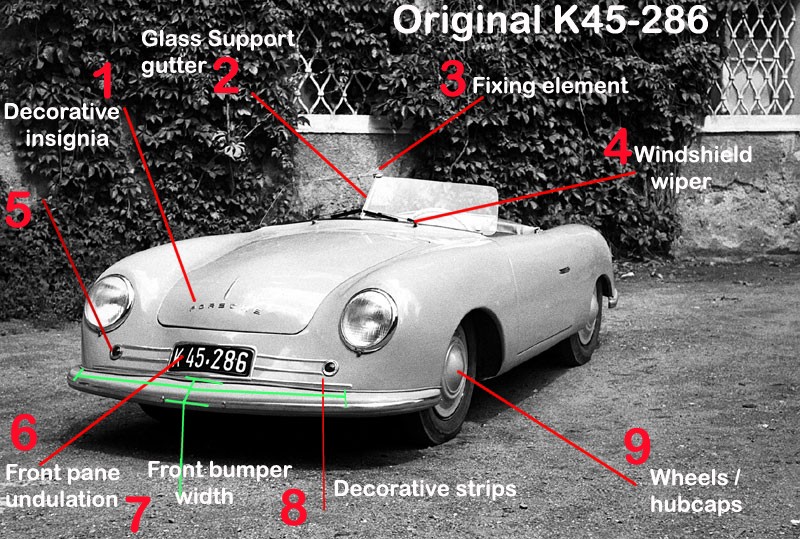
Photo 2:
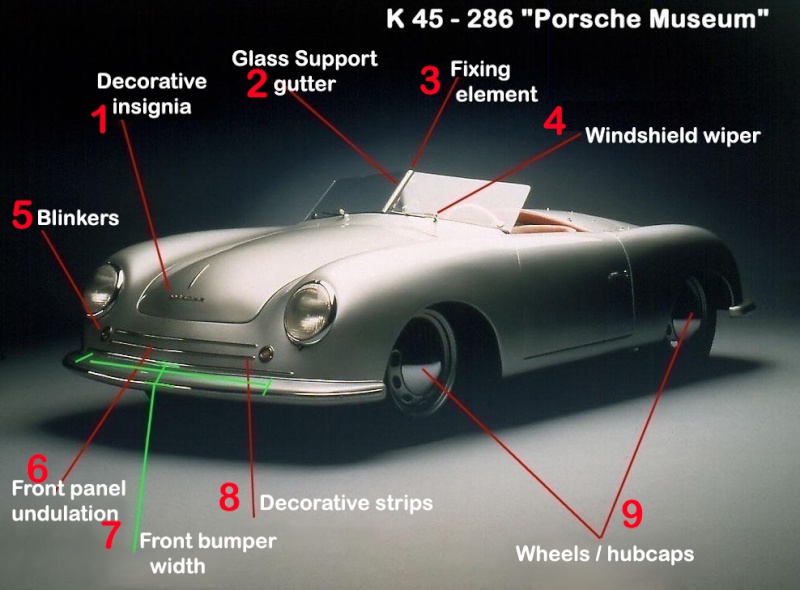
1 – The Decorative Insignia. – here we come across a true offense to Porsche’s History. The reason being that the first “PORSCHE” lettering dating back from 1948 differs in detail from all subsequent letterings of the marquee: each individual letter that composes the word “P*O*R*S*C*H*E” is independent. They were loose letters, individually handmade. Their biggest shortcoming was that with due time, each individual letter would start to loosen and gain it’s own angle. In as much as I’d like to, I couldn’t begin to estimate the value that these handmade letter from Gmünd would have today. The prototype that sits at the Porsche Museum today bears a set of “PORSCHE” lettering that has no resemblance to the original ones. They are letters from a later time (the first of which appeared in 1950) characterized by being united over a single straight line at the bottom of the “PORSCHE” inscription. This style would later be used in the 914, the 911 of 72 and the 924 of 77. The single unifying line would put an end to the problem of the crooked lettering.
Photo:

2 – The gutter uniting the glass panes. – in the 1948 prototype, the gutter that held both glass panes in position existed only on the inside of the car, and not on both inner and outer surfaces, as is the case with the Museum’s prototype.
3 – The Fixing element. – The fact that originally there was only an interior gutter, made it necessary to place a fixing element at the top of the joint, which held the glasses together more safely. This piece no longer exists in today’s car.
4 – Windshield wiper. – In the 1948 prototype, the left windshield wiper laid to the right, the right unit laying to the left. This was due to the movement of the motors being done in opposing directions, from outside to inside. The Museum’s prototype has both wipers resting to the right, the wiper movement being done in sync, from left to right.
5 – Blinkers. – in the older car they are dark and opaque. In the Museum’s unit they’re clear and transparent.
6 – Front Panel Undulation. – This detail is difficult to perceive and confirm, since it is only possible to compare both front panels through photographs. In any case, it would seem to me that originally, the original car’s front panel was significantly more undulated than the current front panel. This could be due to the inexistence of the original wooden molds. The old and new license plates themselves sit differently on the panels. Photo:
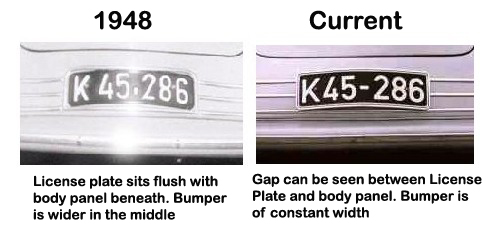
7 – Front Bumper width. – the 1948 original differed in width throughout it’s length, being widest in the middle.
8 – Decorative strips. – although similar, the original strips were longer, reaching all the way to the blinkers’ strips, which is not the case in the current “K45-286”.9 – Wheels/Hubcaps. – yet another aberration. The current prototype opted for the placement of more MOON shaped wheels. These in fact are more elegant than the original ones. However, they totally relinquish the originality of the 1948 model’s hubcaps, much more rustic and simple. Most likely they were lost, since the car wore several different models throughout its racing career, namely the air-cooled but “uncapped” version. The Museum’s prototype bears a set of “Baby Moon” type wheels, made for the model with ventilated brakes (with 10 openings per Wheel – the pre-A model baby moons had no such vents) which would only appear on October 1954.
Photo:
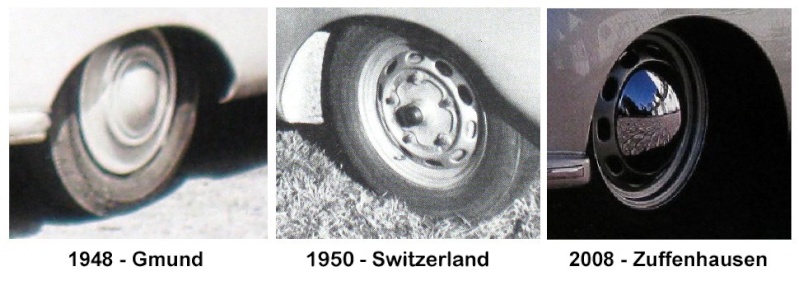
Photo 2: Detail of the simplicity in the 1948 wheels:

12.1. THE “K45-286”’s INTERIOR
Photo:
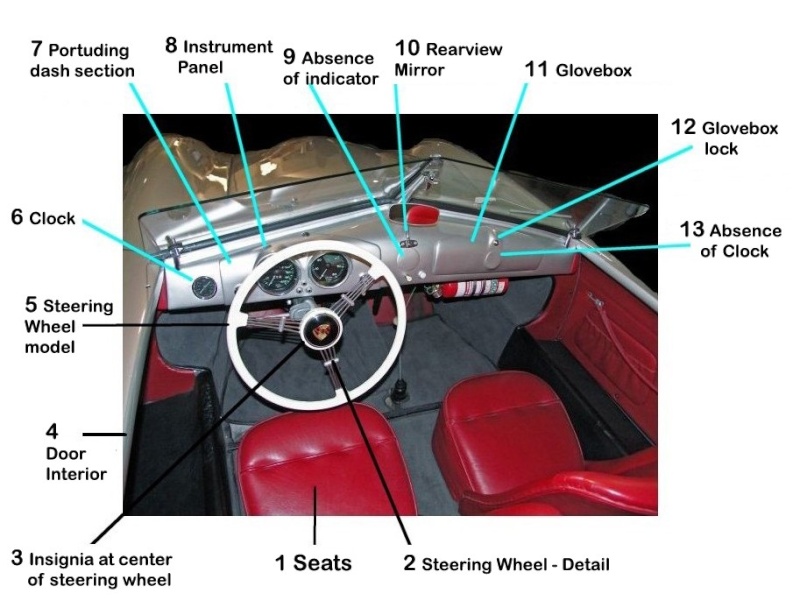
Photo 2:

Sadly, the differences on the inside of the car with respect to the 1948 unit are even more pronounced than the exterior ones. Not a single detail is faithful to the original. And I mean absolutely nothing. Everything is different.
1 – Seats. – the current seats are completely different from the original. The concept of the “bench seat”, “tavern” style, has been completely lost. The Gmünd car was a false 2-seater, since, as its been noted, it allowed for a 3rd passenger. Currently, the 2 individual seats on the Museum’s model are completely vulgar.
2, 5, B) – Steering Wheel and detail. – The first steering Wheel placed on the “K45-286” was an old Volkswagen wheel from the 30’s. It had nothing to do with the sublime and luxurious white PETRI wheel. Most likely, the VW wheel initially used during the first tests was an item snatched from some destroyed military vehicle. The Steering Wheel put in place when the prototype was finished was a wheel manufactured by Gustav Petri, but not the “Banjo” model present in the car today.
Photo: The first Steering Wheel, used in testing:

Photo 2: And the first time it was placed on the prototype:

Photo 3: The “Petri” Range:

Photo 4: The Petri Banjo:
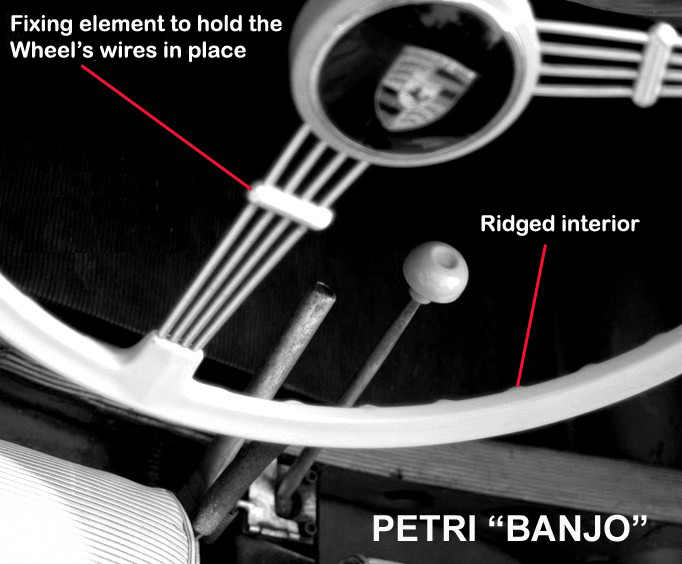
3, A) – Wheel Center. – Yet another heresy, and a major one at that. In 1948, the Porsche logo had yet to be invented! It would be created in 1952. It’s first appearance in a Porsche car being precisely in that position (on the center of the steering Wheel, as a horn) in 1953. The number one prototype would never be able to bear such a logo. The center piece of the Steering Wheel in the original prototype was made of ivory-colored plastic.
4 – Door Interiors. – non-existant in the Gmund 356. The prototype merely had a “map holder” made out of vynil.
6, H) – Clock. – The clock in place at the Museum’s car, does not belong to the Gmünd generation. Furthermore, it’s placed on the left side, when the original one was on the right side of the dashboard, on top of the glovebox. The current clock seems to be a “vulgar” round VDO, not even an older VEIGEL (marked only ant 12, 3, 6 and 9). The original clock was oval and most likely of Austrian origin.
7, C) – Portruding Dash Section. – Totally different design. In the 1948 model this piece was also of a different color from the remaining dashboard, making a contrast.
8, D) – Instrument Panel. – Here, regrettably, there was no respect whatsoever for the original. Not even a care to copy or to imitate it. All the instrumentation on the Museum’s prototype belongs to a much later generation 356. Everything differs, even the type of instruments and the number of indicators. The 1948 car had a simple speedometer and kilometer counter, and was not from VDO as the units in the car today. The Gmünd speedometers were not German, nor were they used in Volkswagens. They were Austrian, manufactured by por F. HEITERICH, in Vienna.
Photo: The post- Gmünd 356 instruments:

Photo 2: The Austrian-origin speedometer:

9 – Marks from absence of indicators. – non-existent in the original car.
10, E) – Rearview Mirror. – tall and with rounded edged on the current car; low and rectangular on the original.
11, 12, 13, F), G) e H) – Glovebox, lock and clock. – The styles are totally different; as are the respective locks. The original was colored differently from the rest of the dashboard (unlike the current one) and had the oval clock place on top of its center, which no longer exists.
Photo:
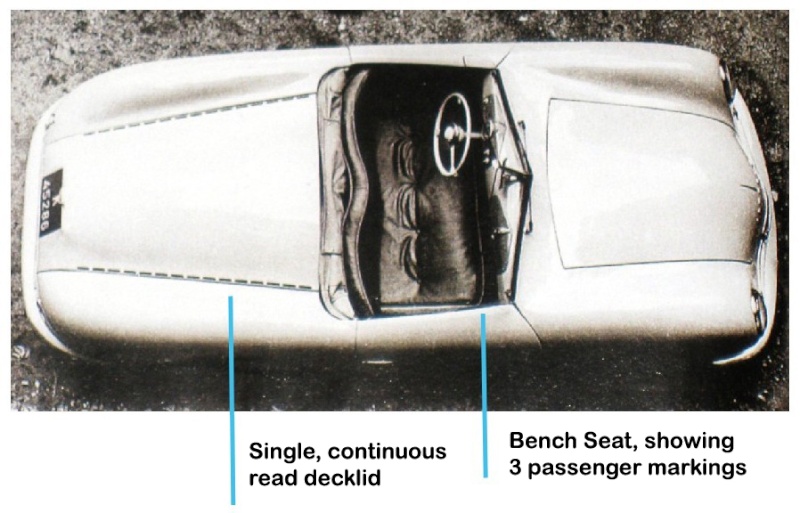
Photo 2:
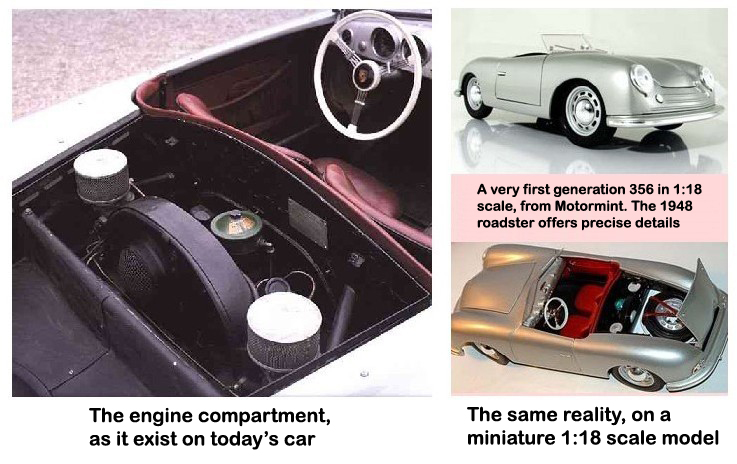
Photo 3: The Engine.
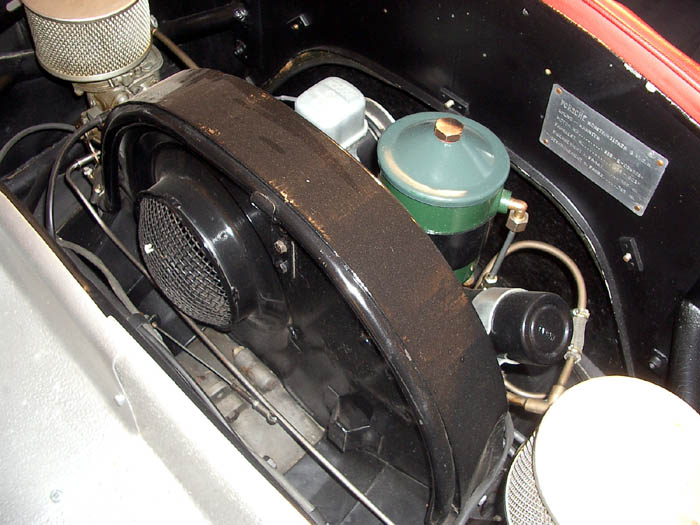
12.2. THE REAR.
Photo:
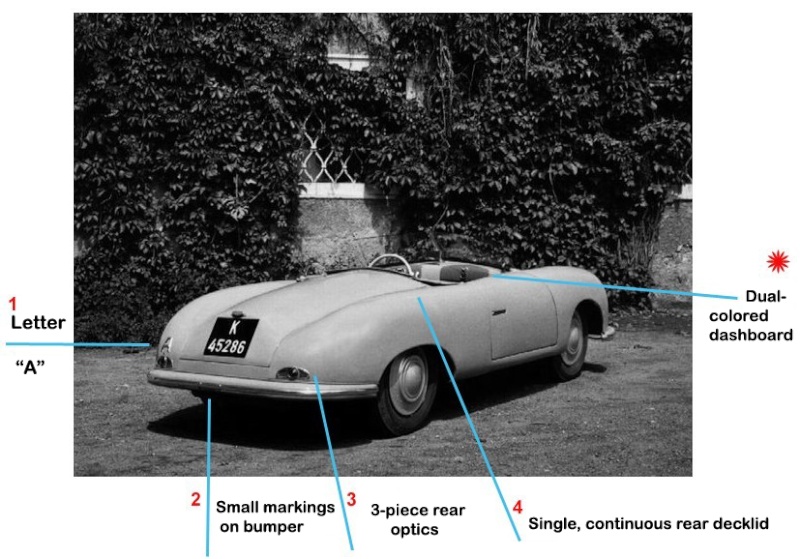
Photo 2:
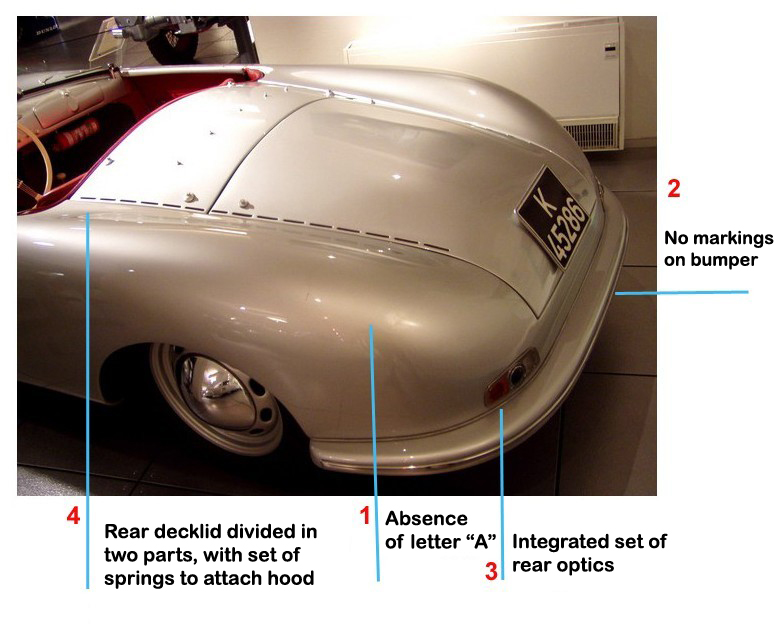
1 – Letter “A”. – Identifying country of origin: Austria.
2 – Markings on the rear bumper. – Non-existent on the current bumper.
3 – Rear Optics. – The original model had 3 independent parts set next to each other. The current car has a single integrated replica.
Photo:

4 – Read decklid. – Made up of a single piece in the original, two-pieced on the current car (not a good sign). Currently, the double function of the rear decklid, serves to make the engine compartment access independent to the spare type compartment. The trunk and gas tank lay beneath the front decklid.
Photo:

13. - THE LIFE OF THE “K45-286” IN IMAGES:
Photo:

Photo 2:

Photo 3:

Photo 4: The main image of the marquee. (this is the original version, showing Erwin Komenda). You will notice that in almost all reproductions of this photograph, the only part of Erwing Komenda that can be seen is the tip of his gabardine.

Photo 5: The car in the Museum and the adjacent description:

Photo 6:

Photo 7: Modern Times:

Photo 8:

Photo 9: Ferry Porsche at the wheel:

Photo 10: The “K45-286” went round the circuit at Nürburgring Nordschleife on August 15th, 1981:

Photo 11: Photo shooting session at Ludwigsburg Castle, near Stuttgart:
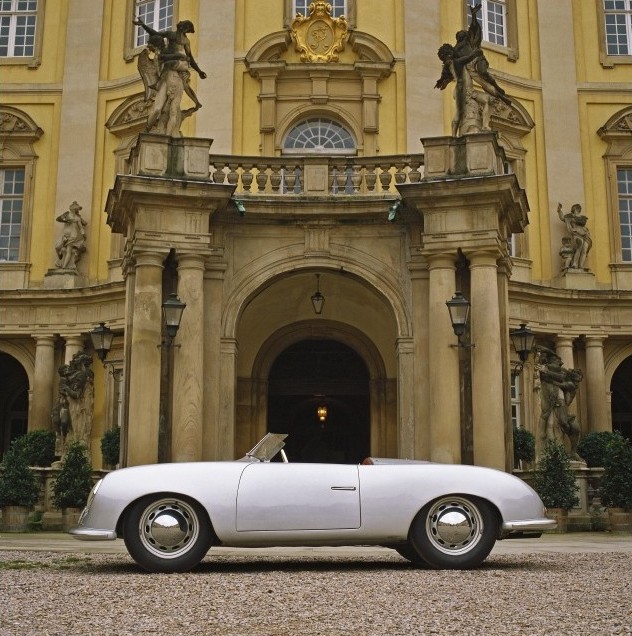
Photo 12:

Photo 13:
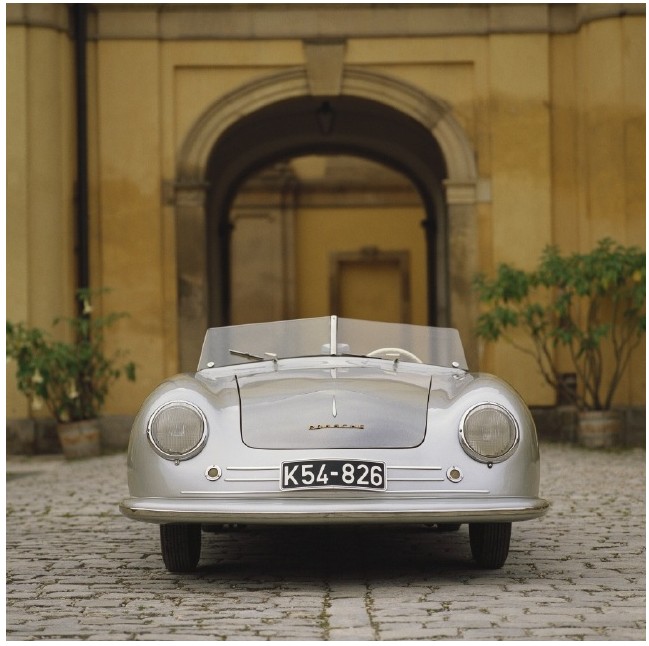
Photo 14:
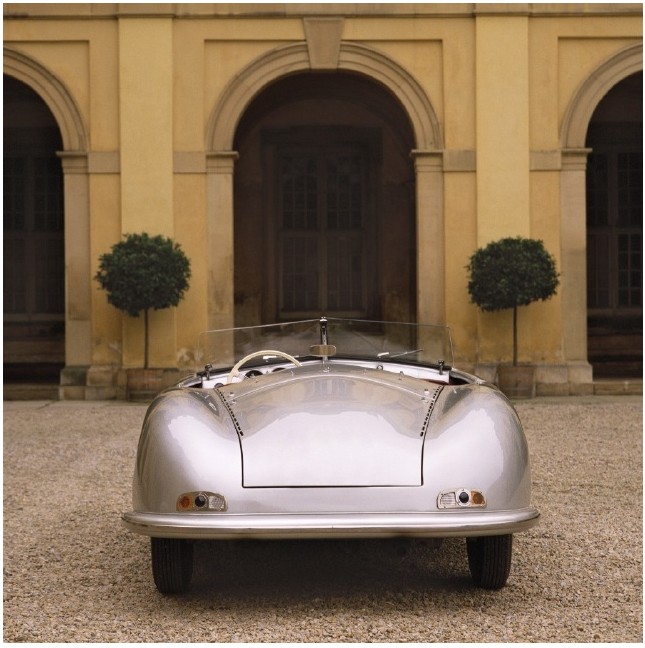
Photo 15:
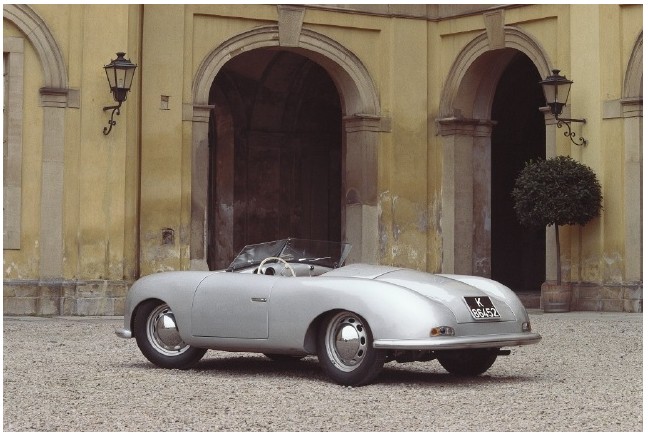
Photo 16:
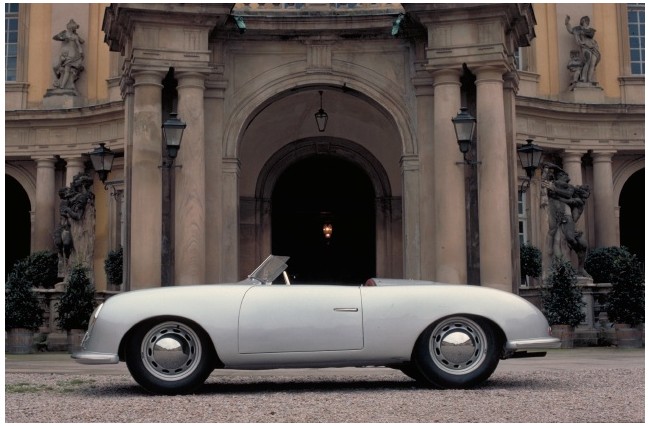
Photo 17:
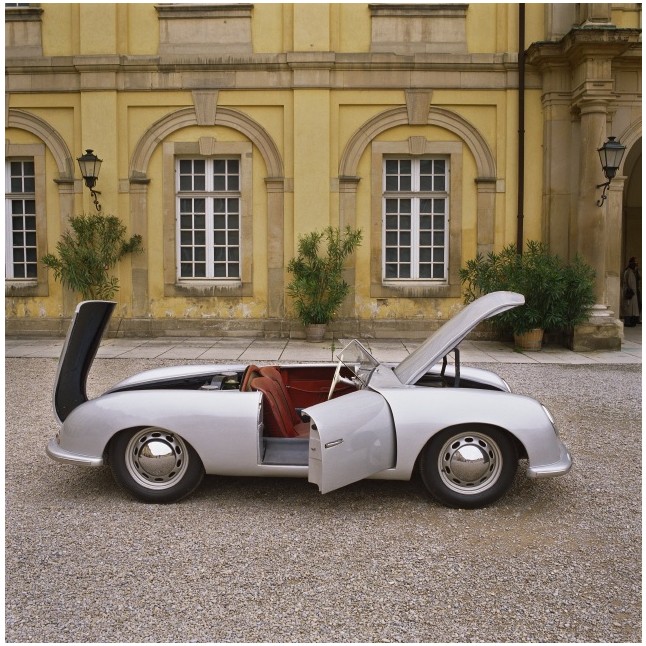
Photo 18:
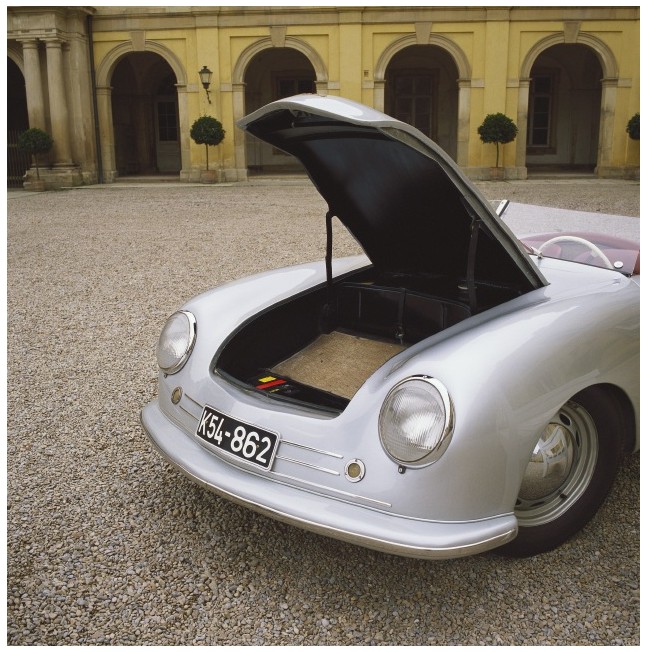
Photo 19:
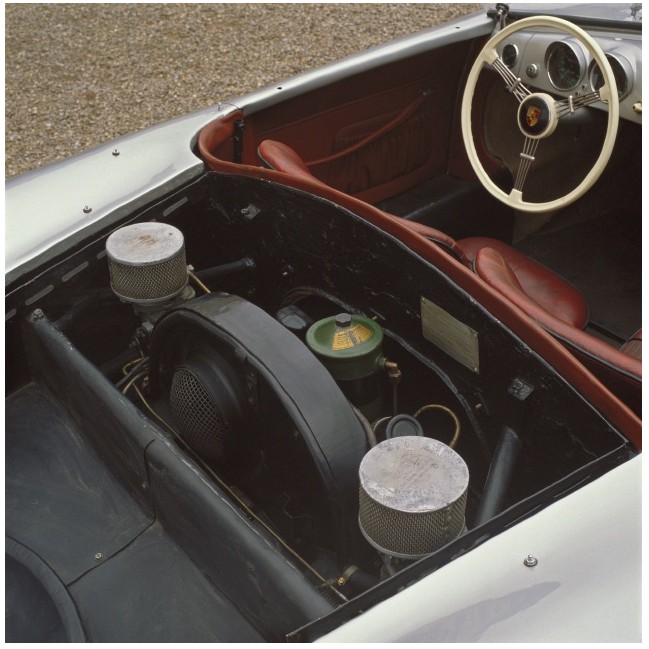
Photo 20:

Photo 21:
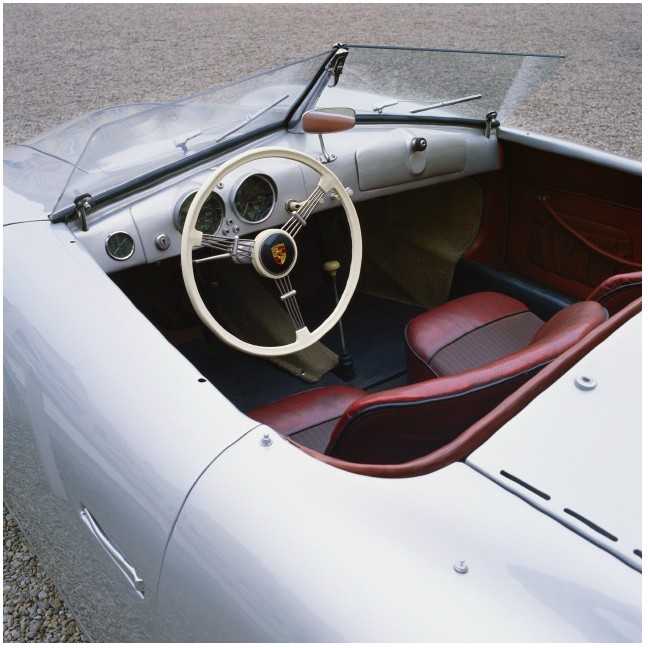
Photo 22:
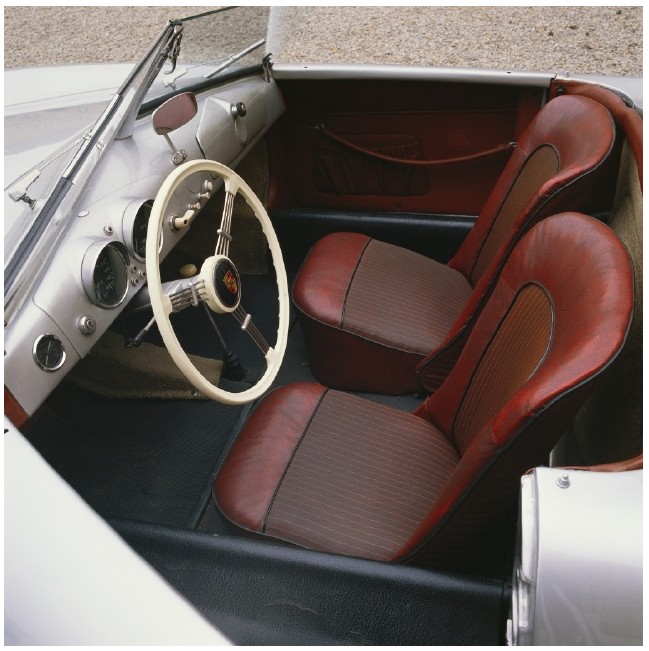
Photo 23:

Photo 24:
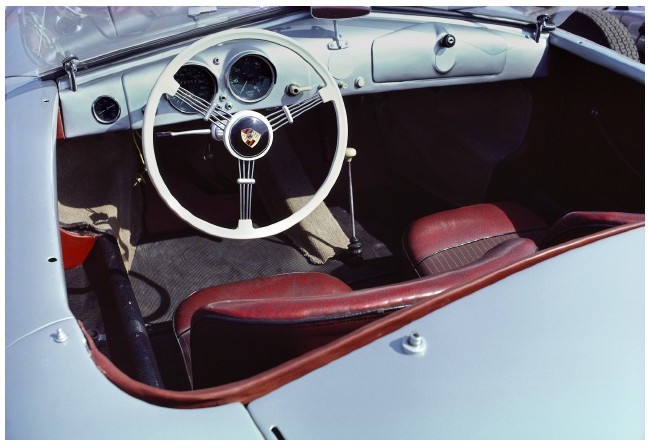
Photo 25:

Photo 26:
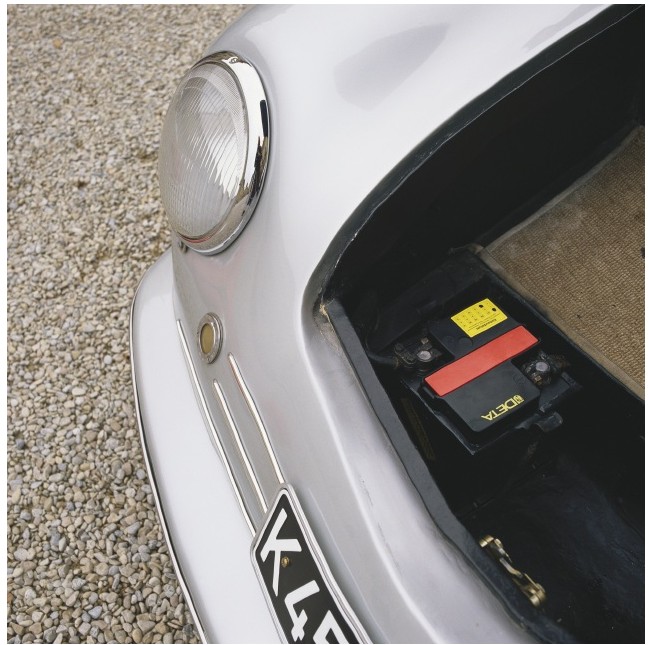
Photo 27:
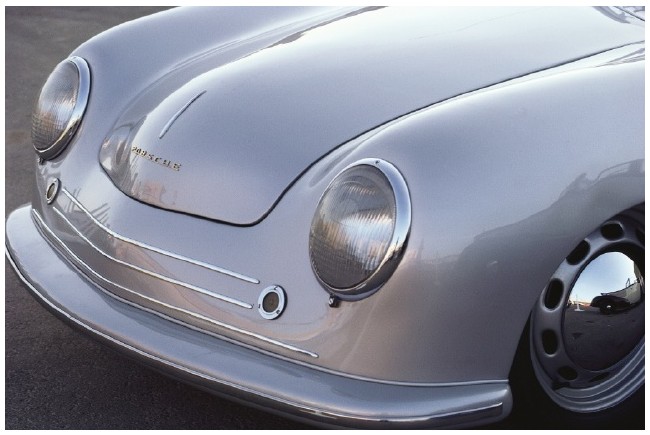
Photo 28: The Legendary Sports Cars, Documentary, 1985
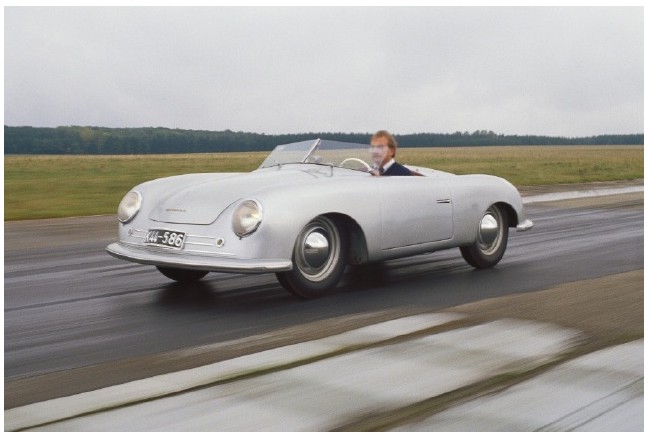
Photo 29:
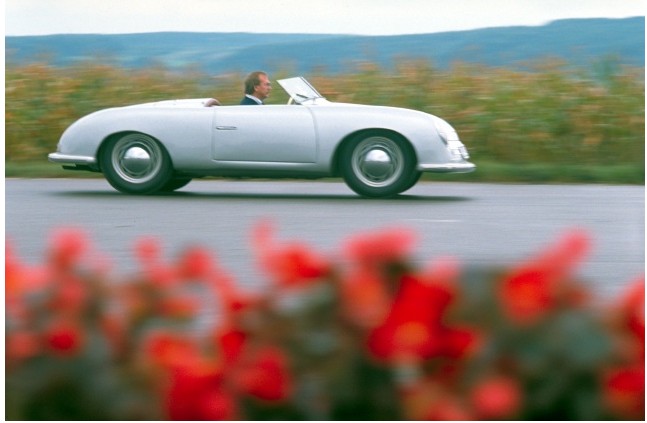
Photo 30:
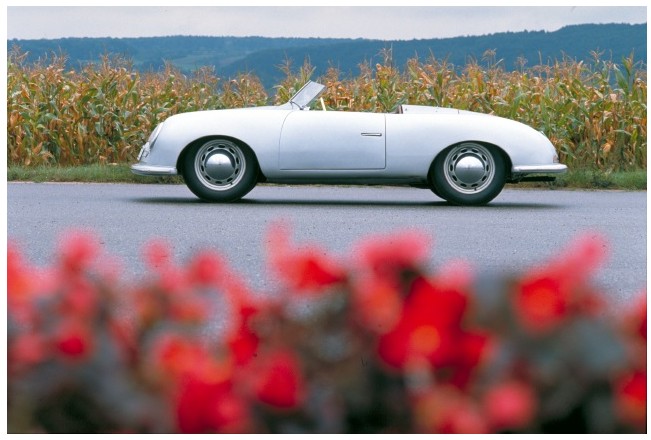
Photo 31: 23-25 April 2004 the "k45-286" was the main star of the Rennsport reunion II event held at Daytona International Speedway:
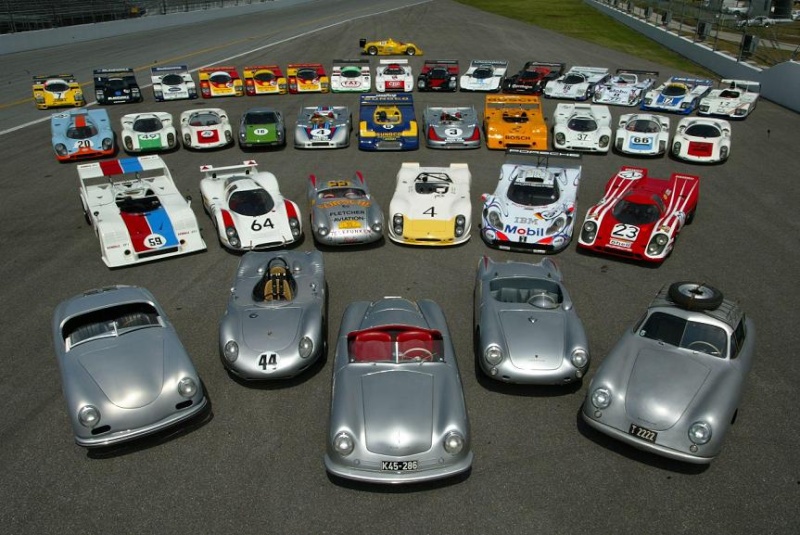
Photo 32:
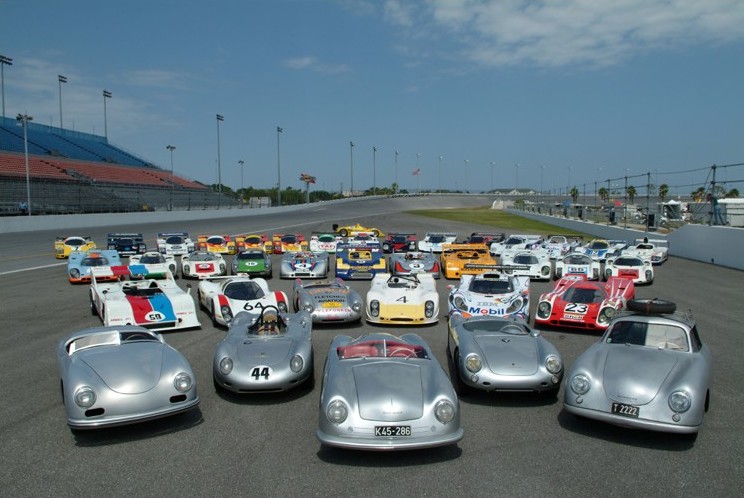
Photo 33:

Photo 34:
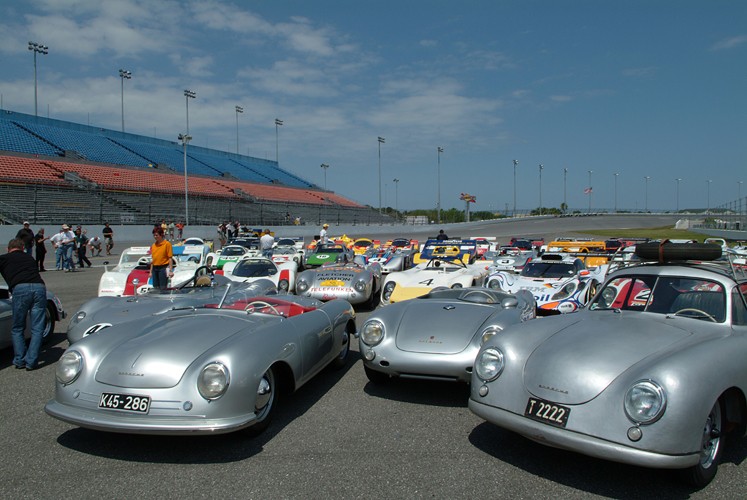
Photo 35: Brian Redman, Klaus Bishof, Norbert Singer:

photo 36:
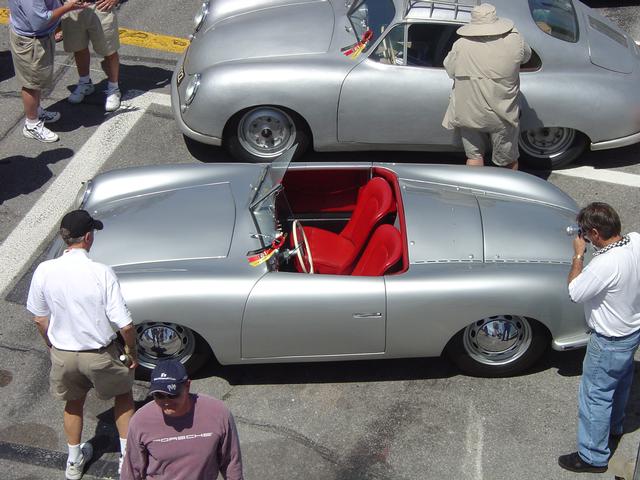
Photo 37: At the Geneva Motor Show 2006 to be displayed at the Swiss car magazine Automobil Revue celebrating the 100th Anniversary:
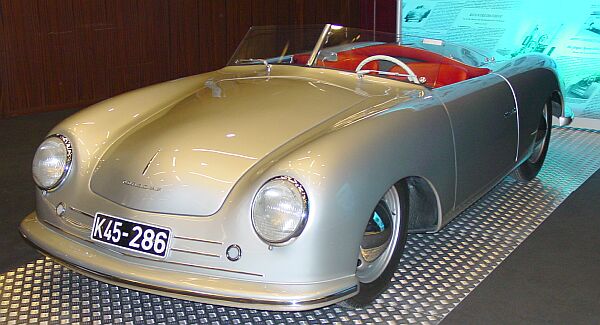
Photo 38: The proud grandson:

Photo 39:
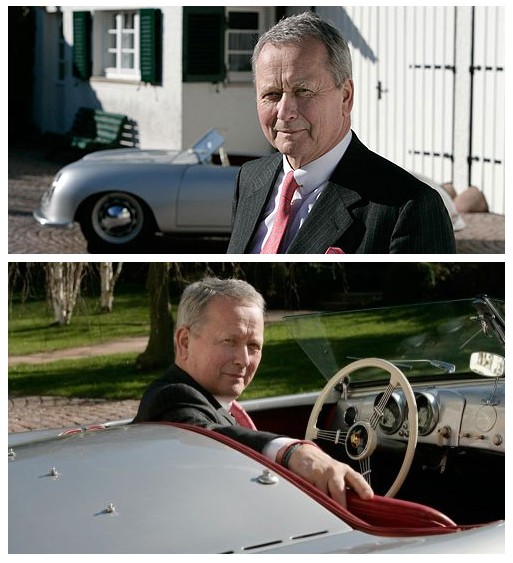
Photo 40: The “k45-286”outside the Werk 1 Cafeteria on the 65th Anniversary day of Wolfgang Porsche, Professor Ferdinand Porsche grand-son:
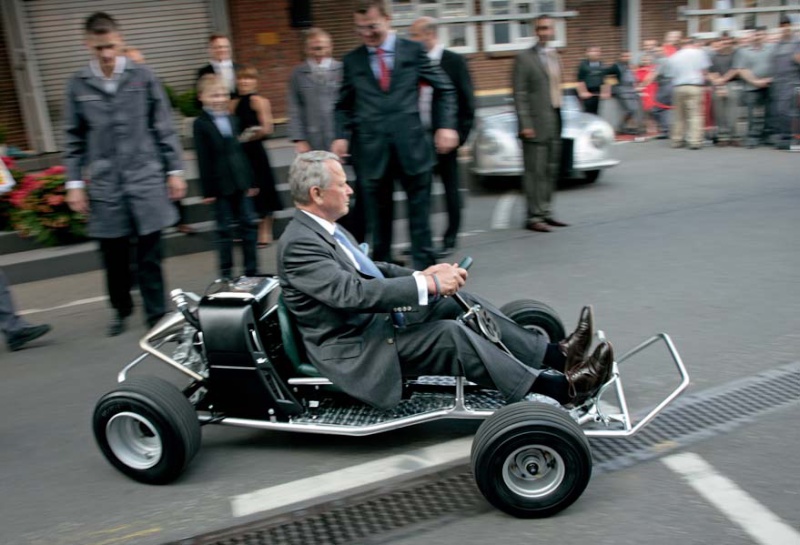
My friend Dr. Fahad Al-Nouri was kind enough to send me these photos, that are included in the publication named: “Porsche 356: Driving in Its Purest Form” by Dirk-Michael Conradt. In the first photograph, we can see the number one prototype with Swiss license plate "SZ-2932", at a gathering in Merano. We can see Ferry Porsche greeting the car’s owner at the time. The second photo shows the ptototype while owned by Hermann Schulthess (its third proprietor) this is the most fascinating photograph of the prototype I’ve seen to this day. An entire family surrendered by the Porsche.
Photo:

Photo 2:
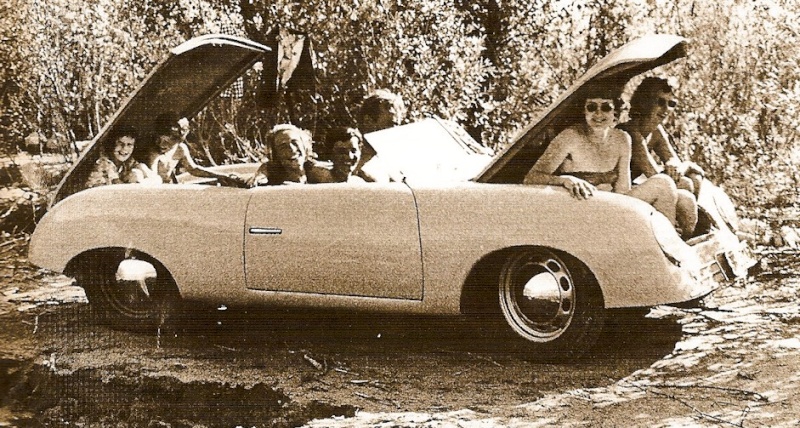
14. THE END OF PART 1.
A final Word about the “K45-286” and about Ferdinand Porsche: As I’m writing these words, the “K45-286” is on its way to the U.S., more precisely California, to participate in the "North American Concours d'Elegance” which will take place August 14th at the famous Pebble Beach elegance venue, held at Pebble Beach Golf Links. The reason for the trip is Porsche’s 60th year celebrations. The decision to send the number one prototype to pebble beach was recently taken at Zuffenhausen headquarters. The decision was taken to ship the car over to the U.S. in order to break the terrible spell cast by the terrible accident that occurred during the 50th anniversary celebrations in 1998. California was the destination of choice, where the car hasn’t been in for the past 10 years. Ferdinand Porsche achieved a lifelong dream of building his own sports car at the very end of his life, thanks to his son Ferry and to his daughter Louise Piëch, who took the reins at Gmund when both Father and Son had to be absent for political reasons. Despite the fact that the first project of a Porsche car was not one of the projects under his direct command, it was only possible due to his work, to his entire life of genius. Without him, nothing would have happened. The war would take a heavy toll on Ferdinand Porsche. His imprisonment in France would be the last fatal shot against his health. He was freed on August 1947 and headed straight for Gmund. Despite being liberated, Ferdinand Porsche was in very poor health during this first phase of the prototype’s construction. He managed to live for an additional couple of years, participating in the project of the first Porsche (albeit more soul than body). This would be his life’s three-hundredth-and-fifity-sixth project. On November 1950, he suffered a heart attack. He passed away at the Marien Hospital at 13H49, on January 30th, 1951, victim of pneumonia. He was in the presence of Ferry, Louise, Dodo, Ghislaine and sisters, Jutta and Marolina Kaes and his Doctors, Dr. Gotz and Dr. Bosler. At 13H46, Father Johannes knelt down on Ferdinand Porsche’s bed for his his last rites. His last journey toward the church and cemetery was done in a car specially requested to Volkswagen. He took his last trip through Grossglockner Hochalpenstrasse, on the way to the green fields of Zell Am See.Faithful or not, present or absent, the “K45-286” shall always be a very special car, at least inside our hearts: The first Porsche. The beginning.

PART 2: THE “K45-286” HAS A LIFE BEYOND THE MUSEUM.
15. “THE INCREDIBLE 60 YEARS” Photo:
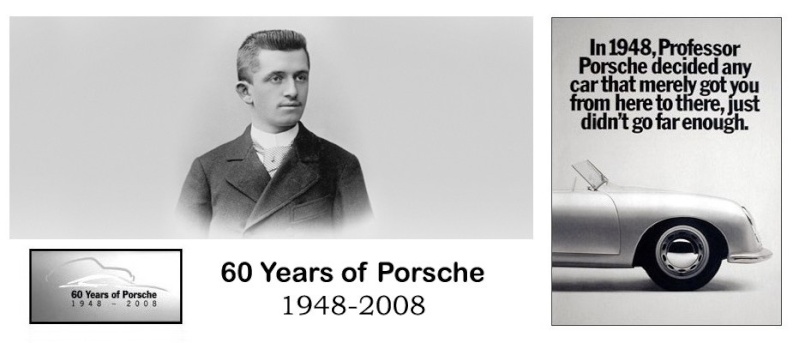
Photo 2:
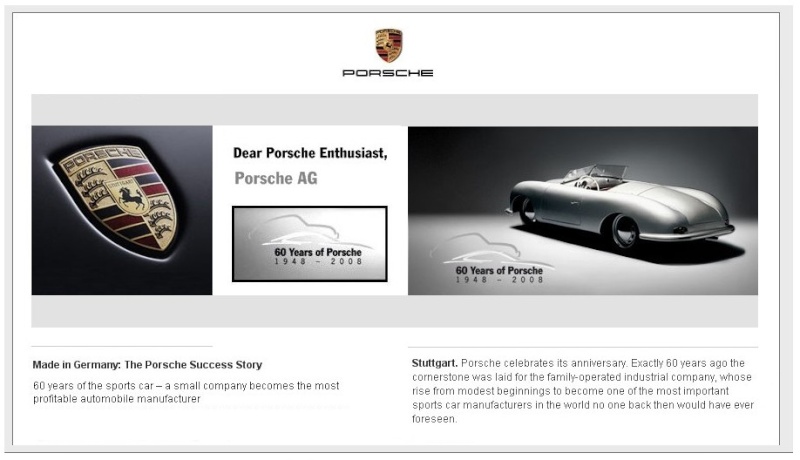
Photo 3:
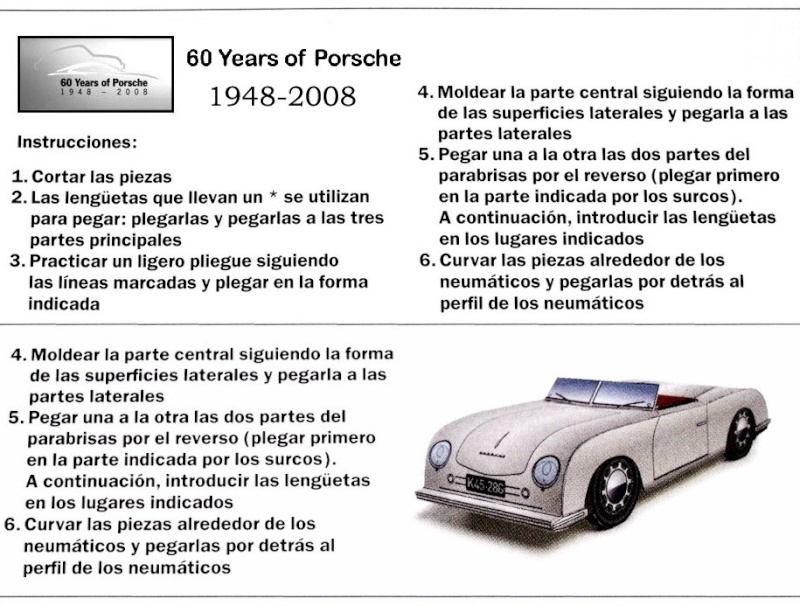
Photo 4:
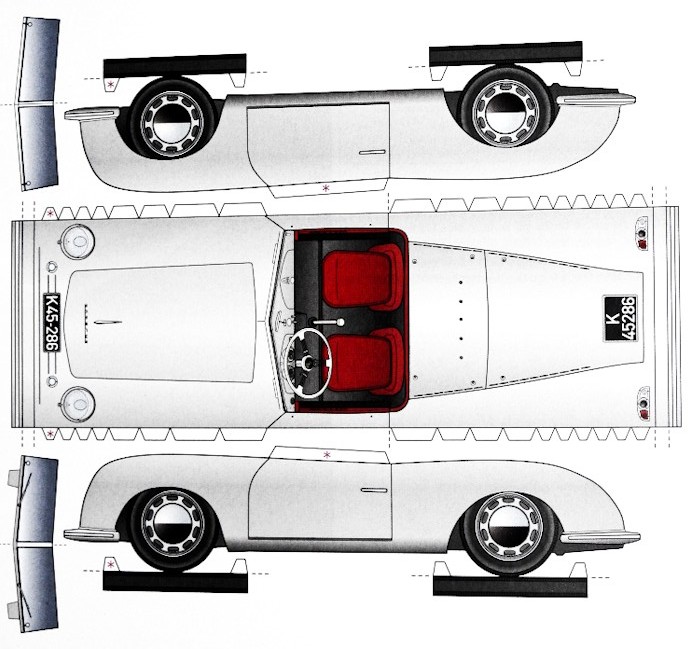
Photo 5:
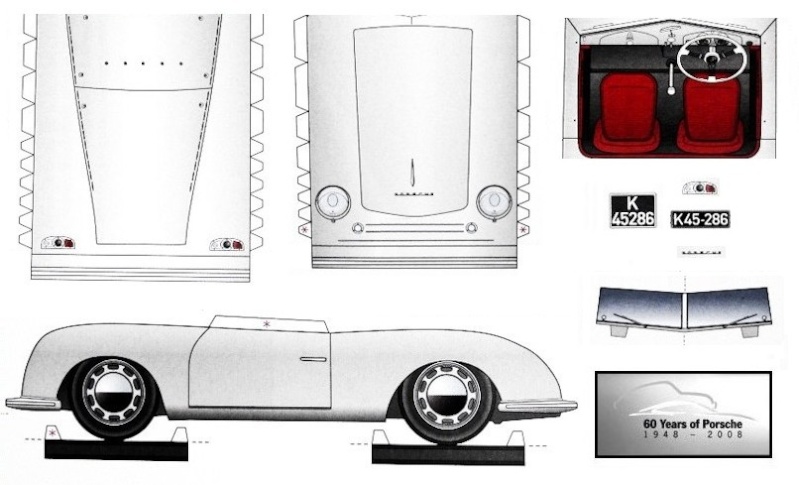
Photo 6: 20/6/2008 – Our hero, Dr. Wendelin Wiedeking, Executive Chairman of the Board at Porsche AG, delivered 4 pedal-powered 911’s to the little winners of a contest that took place at the “Bietigheim Wonderland” event, in Bietigheim, on May 30 and 31st, 2008. The delivery ceremony took place in the museum, blessed by the “K45-286”’s presence.
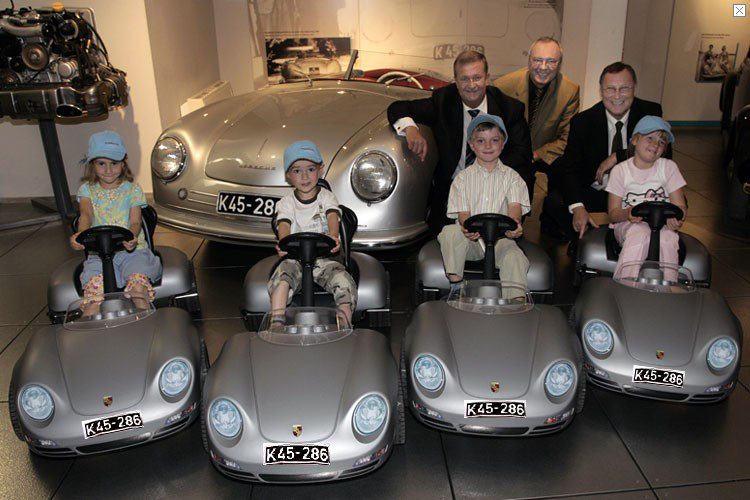
Photo 7: A famous beer maker from Salzburg, Austria, created a special edition of Ferdinand Porsche’s preferred drink. The label shows the “K45-286” projecting a special shadow: a late-generation Porsche 997.
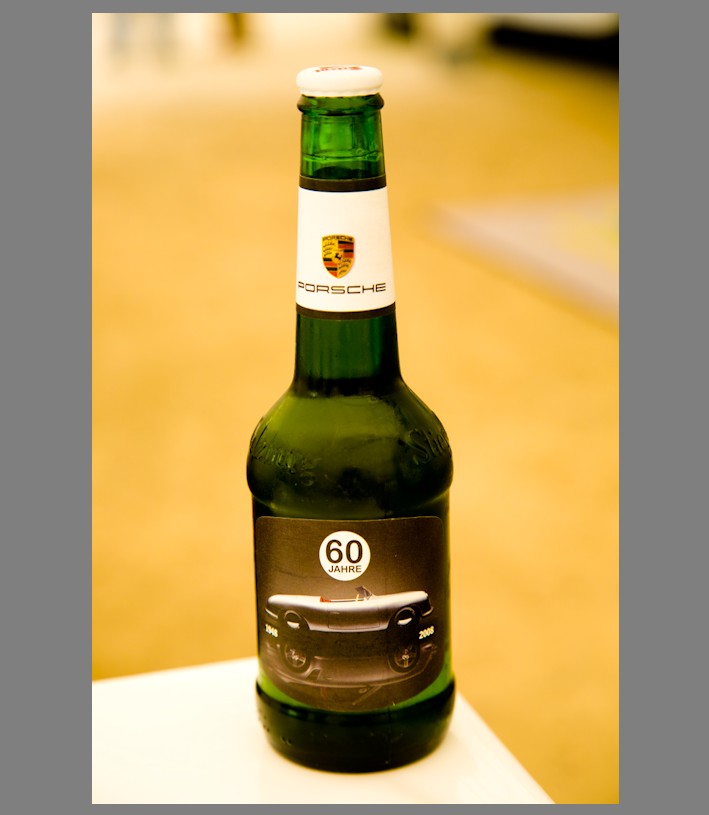
Photo 8:
15. “THE AMERICAN DREAM – DISCOVERING THE CHINESE KITE”. As referred before, the celebrations of Porsche’s 50th anniversary were indelibly stamped with the disgraceful accident suffered by the “K45-286” while on journey to America, where it was meant to pareticipate in the 50th anniversary celebrations held at the Monterrey Historics event in California. The year was 1998. The fall suffered by the car at Chicago O’Hare while being lifted out of the aircraft forced its immediate return to Zuffenhausen The accident had a profound effect at Porsche, not only because it occurred in its 50th anniversary, but also because 2 days prior, on March 27th of that fateful year of 1998, Ferry Porsche died. The loss of Porsche’s creator only days before the 50th anniversary celebrations was a very heavy blow to the marquee. The K45-286’s trip to America would serve more than anything, to steer the festivities far away from a mourning Stuttgart. 10 long years would go by before Porsche would once again venture into sending the number one prototype to America. Precisely on the year – as we all know – that marks Porsche’s 60th anniversary. Finally, the “K45-286” is able to accomplish an American Dream, prematurely interrupted a decade ago. The presence of the number one in the land of Uncle Sam is more than fair. Firstly, because Americans are the most enthusiastic Porschfiles on earth, and secondly, because that continent represents Porsche’s biggest and most important market. The chosen location for its exhibition was the “Pebble Beach Concours d’Elegance” that took p’lace at the Pebble Beach Golf Links, in Southern California. Prior to participating at the Concours, the “K45-286” was also exhibited in Atlanta, at the Porsche Norte America (PCNA) headquarters.
Photo: The press release for the Grand Event:
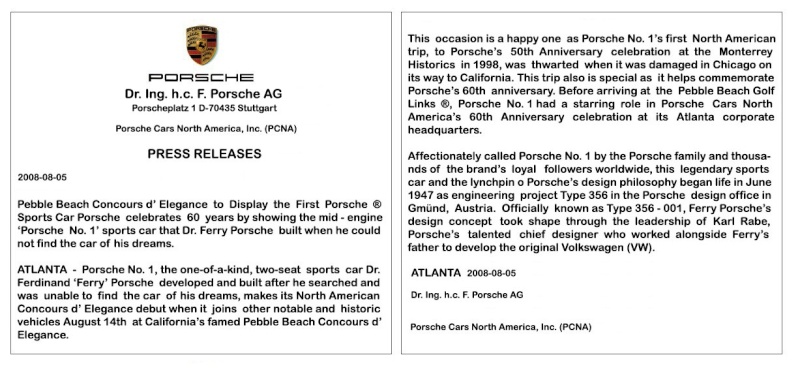
I’d like to open a parenthesis to thank the precious contribution that arrived from America by way of two Porschefile Friends that weke kind enough to send me the Photos of the “K45-286” for these two events. Anyone acquainted with me knows how much I was “dying” to see them. The 50th-anniversary curse was finally broken. Many thanks to PETER RITTER for the excellent photos taken at Peeble Beach and to ANDREW BELDECOS for the beautiful shots taken in Atlanta. PETER even managed for Klaus Bischof to pose for him in front of the prototype. A historical photo, since Bischof is nothing less than Director of the Porsche Museum at Zuffenhausen. Also excellent and a reference to me, is the article published by DAN NEIL of the Los Angeles Times, entitled “Brand DNA and the prototypical Porsche”. Dan Neil was a very special guest, since he was given the opportunity to drive the “K45-286”, na experience not in reach for most mere mortals. Klaus Bischof confided to him that he’d been the 5th person ever to be allowed to drive the prototype since the 50’s. The list of the other four is easy to guess: Bischof himself (currently its most assiduous driver) Ferry Porsche, Wolfgang Porsche and Hermann Rüttger. Still, I can almost swear I’ve seen more people at the wheel in the past years. At least with the car standing still. Dan’s test drive led him to consider the car surprisingly small. According to Bishof this was tradition consequent to the low average stature of the Porsches, who liked their cars made to their masures. My favorite phrase, mythical even, was the one Dan Neil stated to best interpret what he felt as he drove the car: “it’s like a Chinese kite on wheels”. Brilliant. Another curious aspect was Klaus Bishof’s explanation as to the car’s ignition being on the left side of the steering column. According to him, there were 3 main reasons: to save electrical wiring, to save Money, and to save 200 grams on the car’s weight.
Photo 2: Atlanta. ANDREW BELDECOS photos:
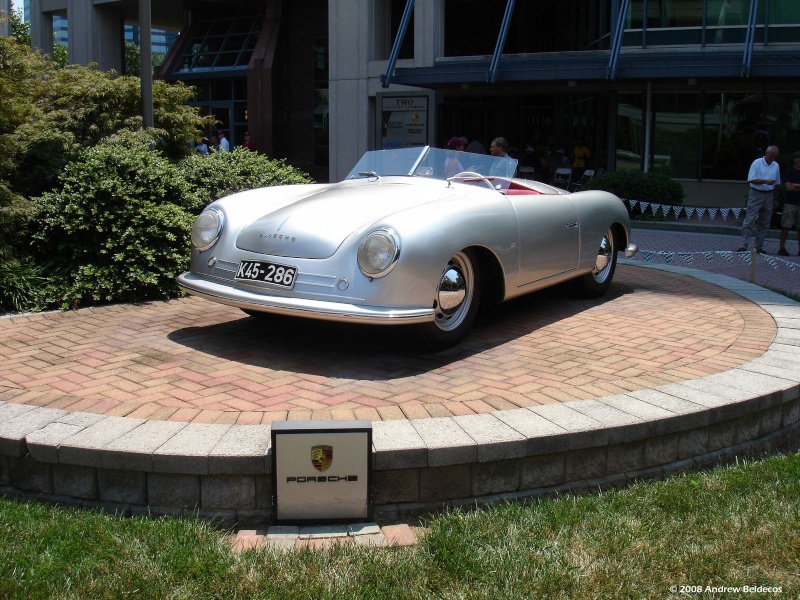
Photo 3:

Photo 4:
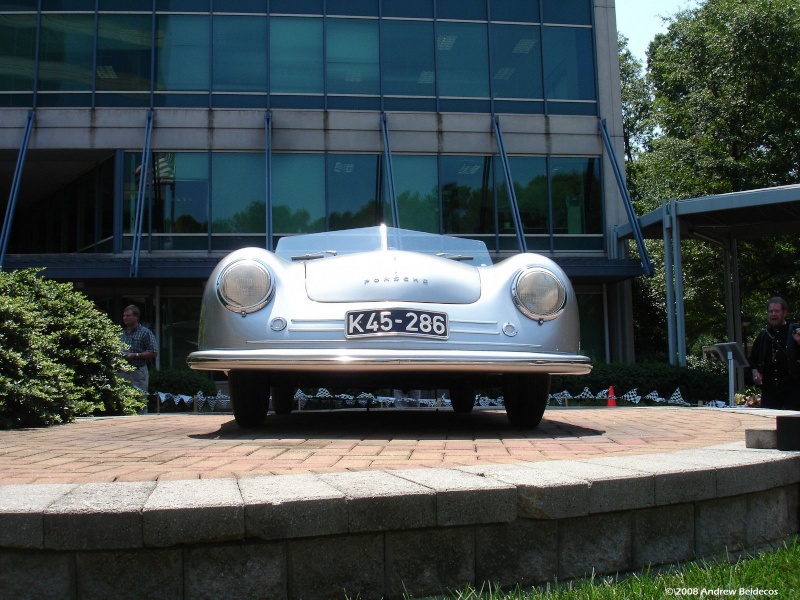
Photo 5:
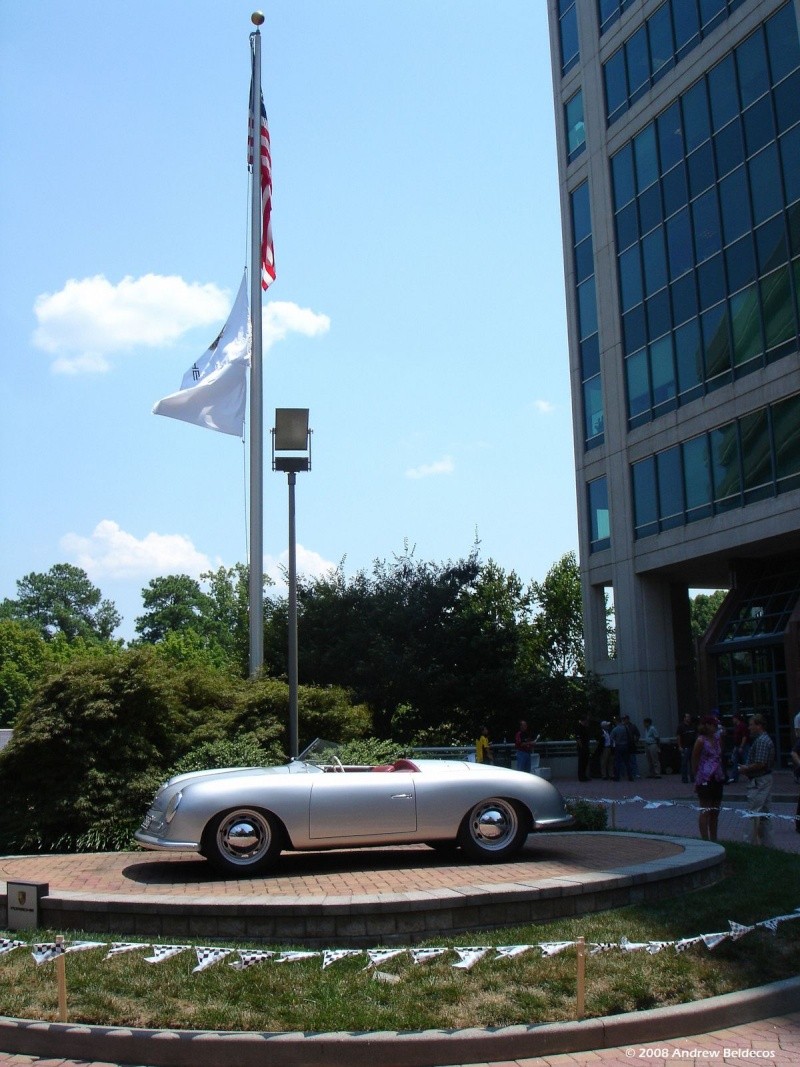
Photo 6:
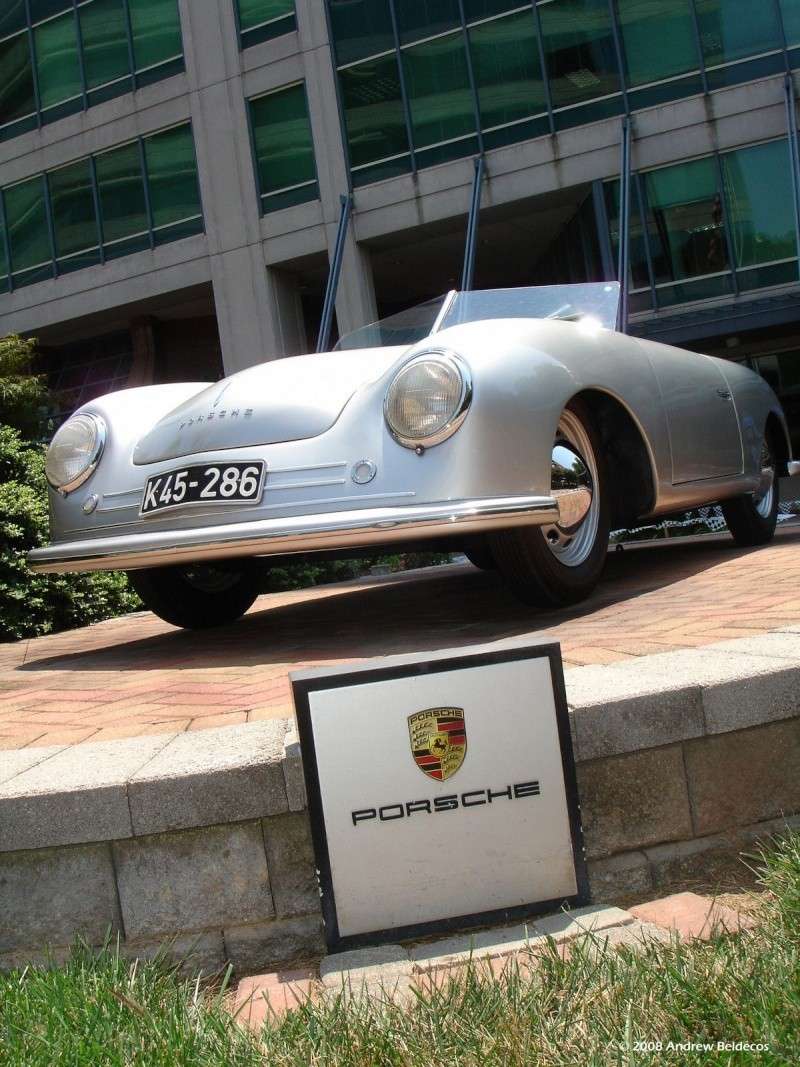
Photo 7: PETER RITTER photos on Peeble Beach:
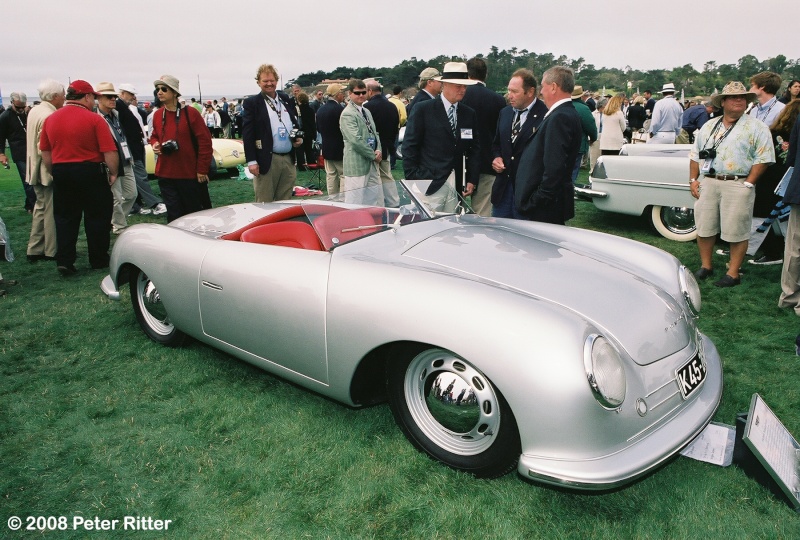
Photo 8:
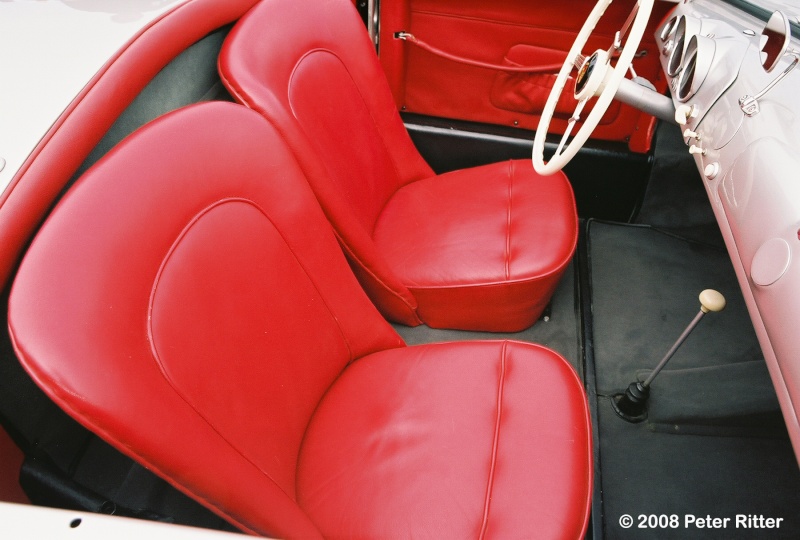
Photo 9:
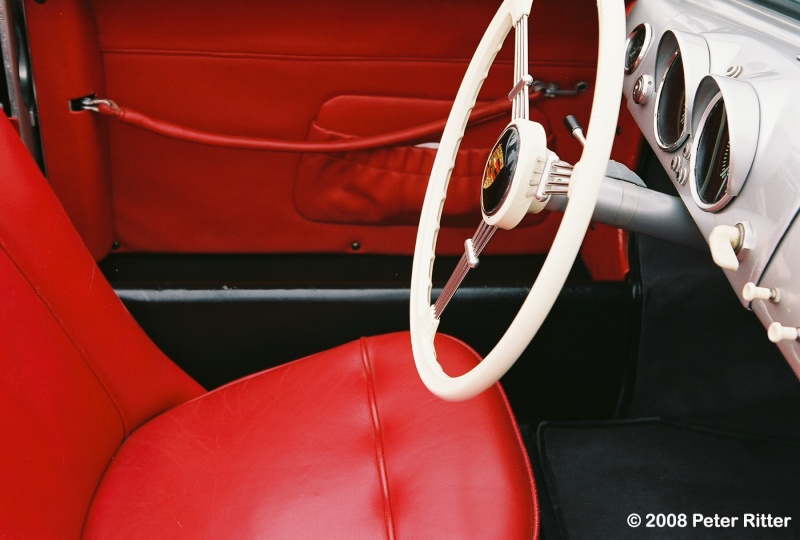
Photo 10:
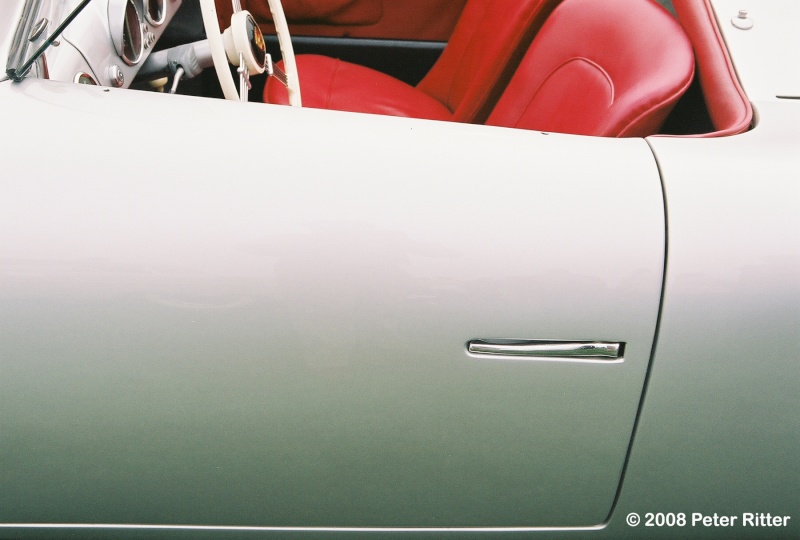
Photo 11:
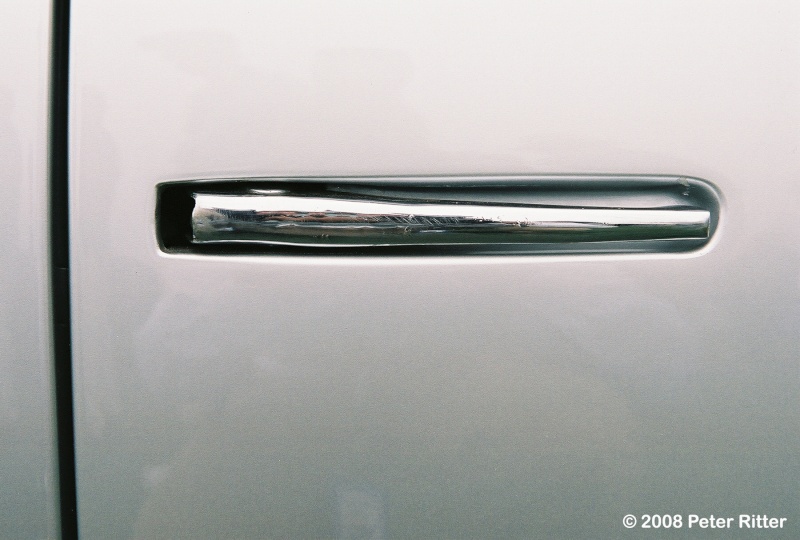
Photo 12:

Photo 13:
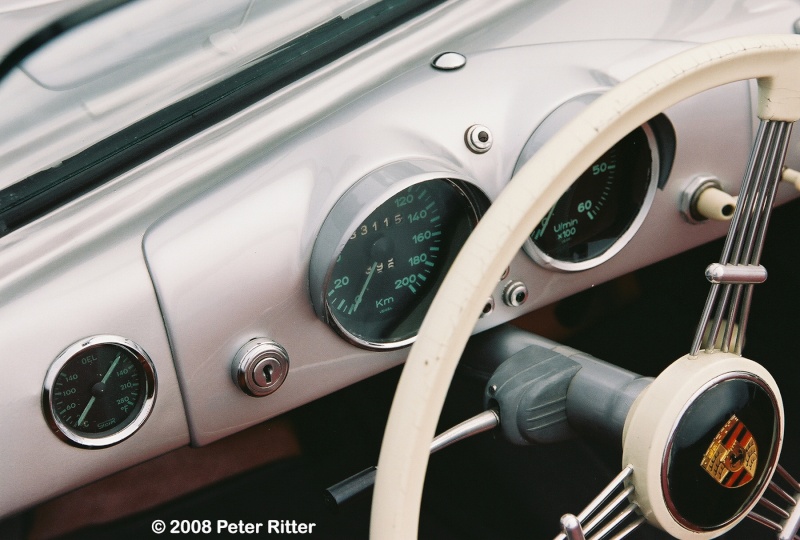
Photo 14: a proud Klaus Bishof:
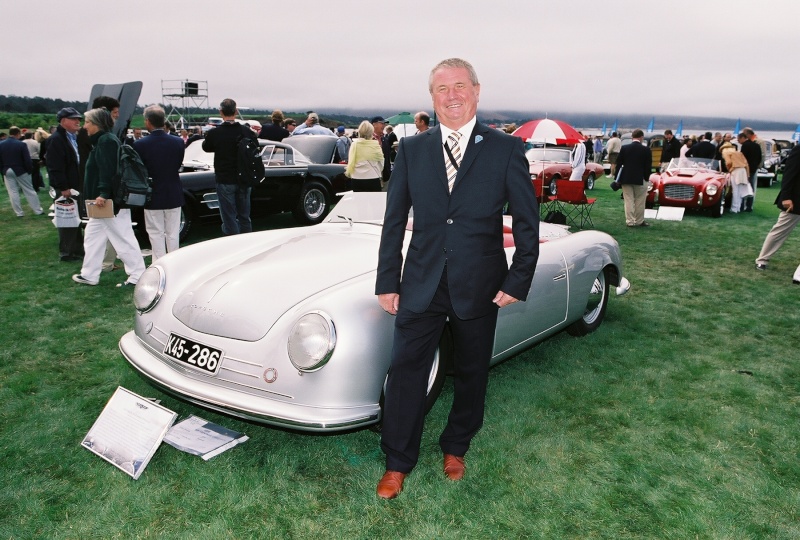
Photo 15: The reason for this Blog: a license plate from Carinthia:
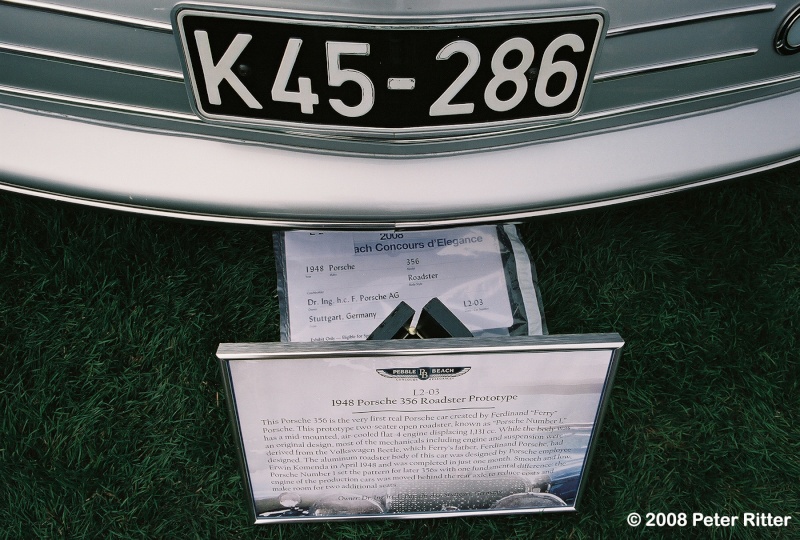
Photo 16: The comparison against the American product:

Photo 17: Starting line for the “K45-286”:
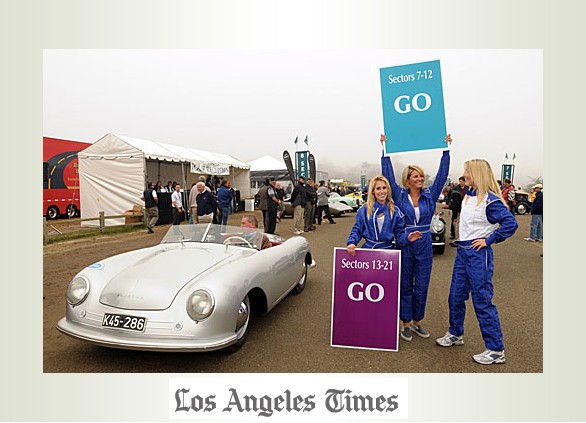
Photo 18: Dan Neil happy at the wheel:
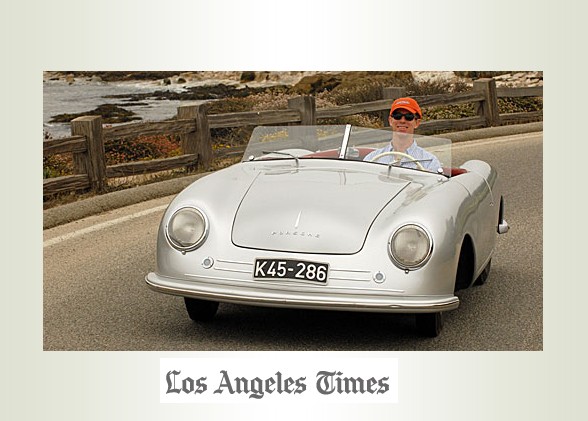
16. THE “K45-286” PLATE - THE AUSTRIAN VEHICLES IDENTIFICATION SYSTEM.
(Portuguese version only)
Photo:
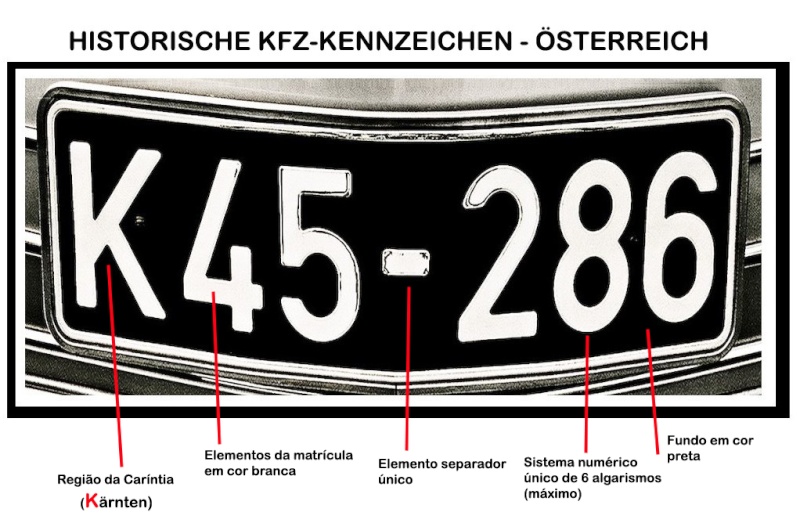
O primeiro carro da Porsche, aqui objecto de atenção, tem diversas e distintas designações. Uns chamam-lhe "protótipo 356". Outros “356 roadster”, o “n.º1” ou como a própria família Porsche sempre lhe chamou: “O primeiro”. Como já deve ter dado para ver, eu chamo-lhe “K45-286”, e também uso as outras designações apenas para não soar a papagaio. Referir-me ao carro pela matrícula, talvez tenha a ver com o facto de ela ser a coisa mais original que o automóvel tem e por eu não me identificar muito com esta versão arranjadinha do “primeiro”. Posto isto, A primeira matrícula austríaca apareceu em 7 de Janeiro de 1906 em Viena, sob imposição da governação do Império Austro-Húngaro. Pode parecer muito tempo, mas nesta altura já circulavam muitos veículos por toda a Europa. Quem não está familiarizado com este Império, e para que tenha uma ideia da sua dimensão, basta dizer que correspondia a 13 actuais países: Áustria, Hungria, República Checa, Eslováquia, Eslovénia, Croácia, Bósnia e Herzegovina e as regiões da Voivodina na Sérvia, Bocas de Kotor no Montenegro, Trentino-Alto Ádige e Trieste na Itália, Transilvânia e parte do Banato na Roménia, Galícia na Polónia e Ruténia (região Subcarpática) na Ucrânia. As matrículas eram de muita simplicidade, feitas em chapa, apostas à frente e a trás, com inscrições a preto em fundo branco. Existiam 17 letras que correspondiam aos diferentes Reinos do Império Austro-húngaro bem como algumas destinadas aos veículos a determinadas forças públicas do Império, como era o caso da Polícia. As primeiras matrículas para além da letra só tinham uma numeração com três números. Claro está que, numa extensão tão grande que cobria grande parte da Europa, rapidamente a numeração ficou esgotada. Até porque a Indústria automóvel, evoluía de ano para ano. Para colmatar esta falha, atribuíram-se numerações contínuas aos veículos do Império, sendo que todos os demais tinham a separar a letra dos n.ºs um espaço. Esgotada esta débil solução, foi “fundido” ao sistema de numeração esgotado, uma nova numeração, exactamente igual à primeira, mas de origem romana, dobrando-se assim o n.º de combinações possíveis. Esta metodologia de organização registral acabou, porém, de lançar alguma confusão e algumas matrículas que anteriormente eram muito simples passaram a ser complicadas, por ex. KXIV 746. A dissolução do Império veio trazer uma profunda reorganização administrativa, bem como posteriormente após a ocupação Russa. O certo é que, até chegarmos ao sistema de matriculação que nos interessa, irão suceder ainda outros 2 diferentes conjuntos de regras de organização de sinais distintivos. Vão aparecer brasões e desaparecer brasões; vão mudar cores e extensão da matrícula. A matrícula “K-45-286” vai integrar o quarto sistema organizativo instituído precisamente em 1947, na altura em que o primeiro Porsche estava a ser construído. A Áustria foi dividida em Estados que agregavam 11 regiões: a cada uma dessas regiões era atribuída uma letra. B Burgenland, G Graz (capital do estado Estíria), K Caríntia, L Linz (capital da Alta Áustria), N Baixa Áustria, Ó Alta Áustria (sem estado capital Linz), S Salzburgo, St Estíria (com excepção da cidade de Graz), T Tirol, V Vorarlberg, W Viena As características foram originárias de 1939: painéis em chapa preta com inscrições a branco, elemento separador e ausência de qualquer escudo ou brasão. Até 1947 aparecia à esquerda o brasão federal, e à direita o brasão do país. Os veículos estatais (como por ex. o dos transportes públicos) eram os únicos que apresentavam duas letras. O sistema numérico representante do código do país estendia-se até um máximo de 6 dígitos.
17. FOR KEEPS.
Photo :
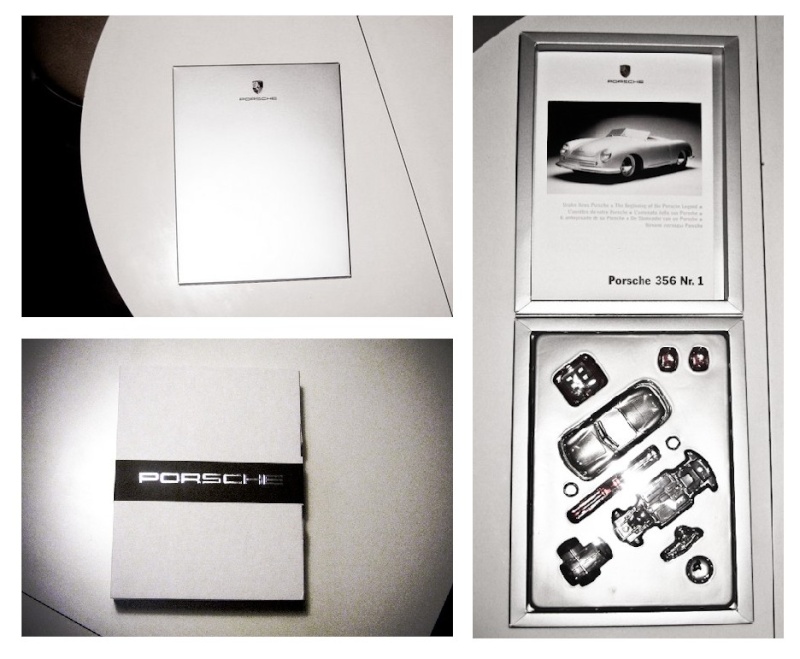
Photo 2:

Photo 3:

Photo: Very rare "Top Trumps" card where we can see the N.º 1 at Zuffenhausen before it's restoration process:

Photo 2:
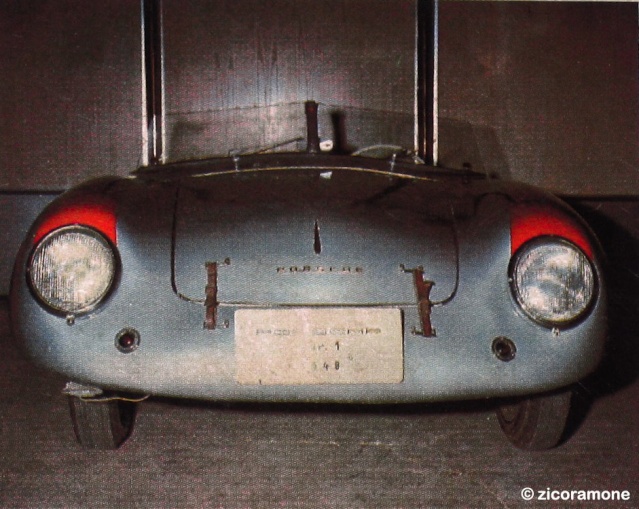
18. - BROCHURES, CATALOGS AND MAGAZINES.
Photo: 1978 “The Porsche Family Tree”Porsche + Audi Brochure:

Photo 2: Porsche News 01 year 2008:
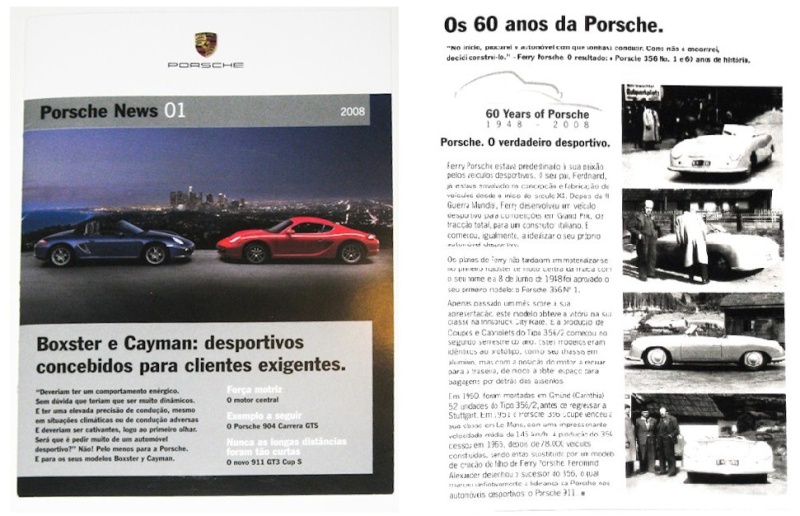
Photo 3: “Excellence” October 2008:
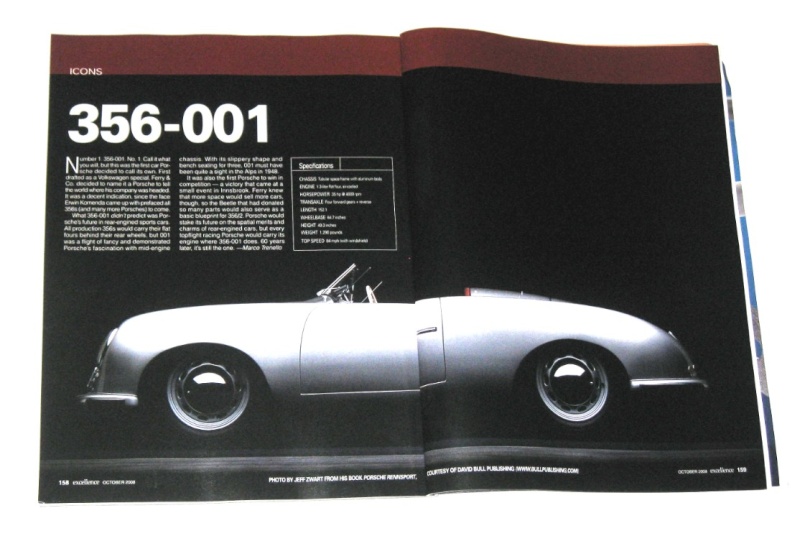
*...and to all Porsche Fans ;-)
Photo 4: "DeA" 1/43 PORSCHE 356 No 1 ROADSTER 1948:
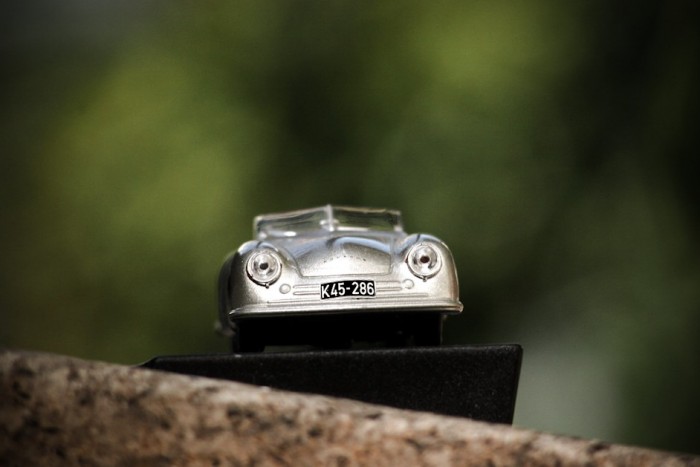
Photo 5:

Photo 6: TESTORS Porsche 356 Prototype no. 1 Roadster Limited Edition KIT (Thailand)

Photo 7:

Photo 8:

Photo 9: PORSCHE HERITAGE COLLECTION. 1948 Porsche Nr. 1, Typ 356 Roadster Paul's Model Art GmbH for Minichamps. Limited Edition scale 1:43:

Photo 10:
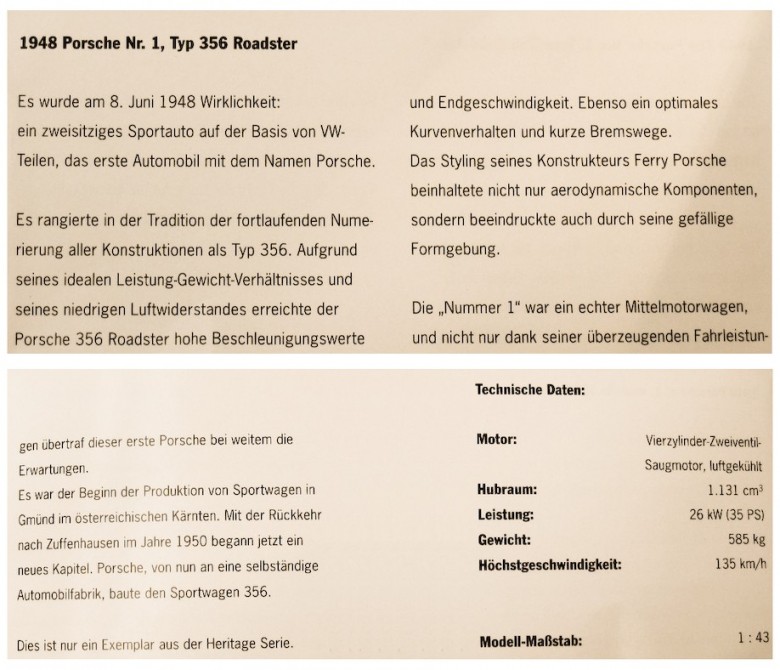
Photo 11:

Photo 12:

Photo 13:
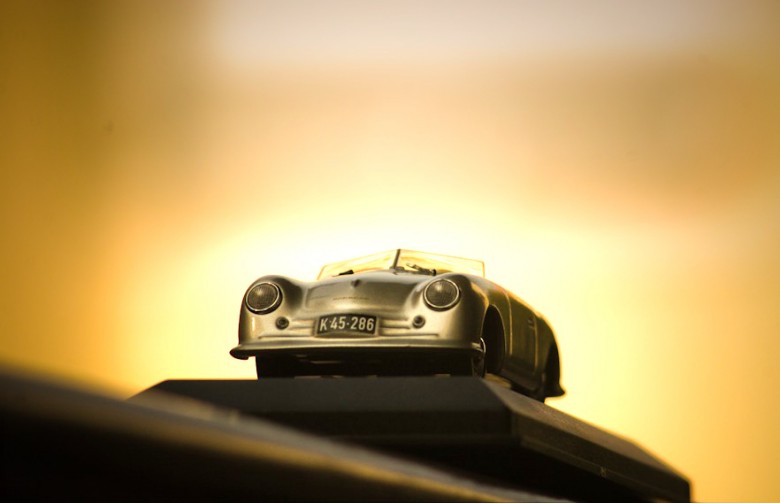
Photo 14:
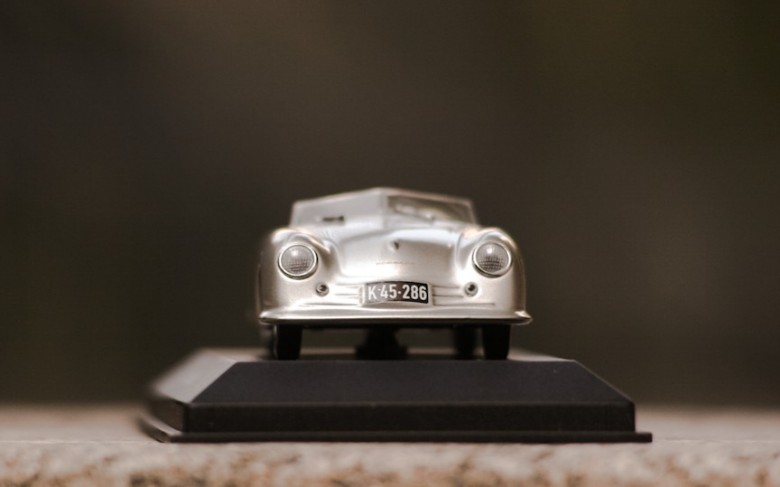
Photo 15:
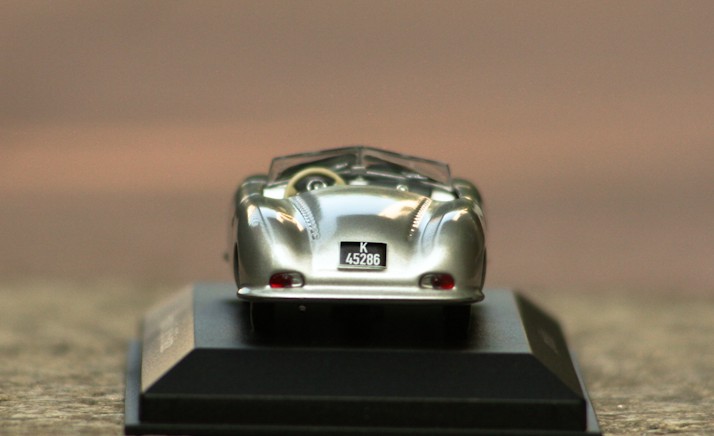
Photo 16:

Photo 17:
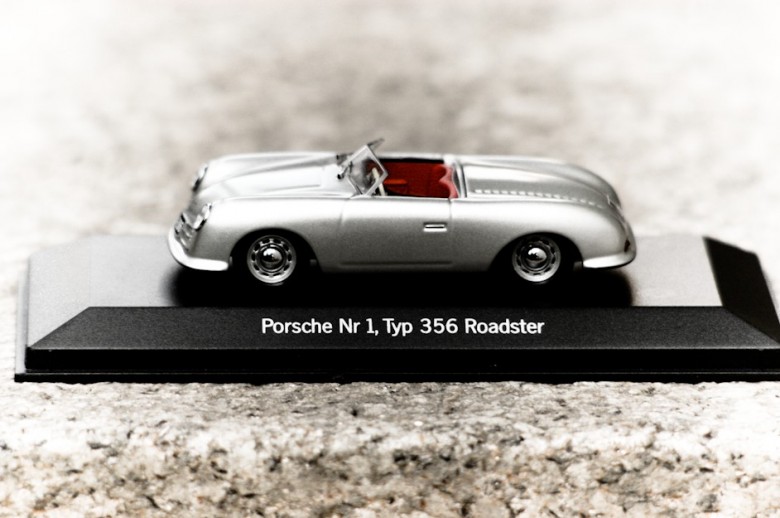
Bibliography (partial;-) ): Dr. Ing. h.c. F. Porsche AG www.porsche.com / Porsche Engineering Group G mbH Porschestraße D - 71287 Weissach / http://www.porsche-holding.at/ / Porsche Consulting GmbH / Porsche Holding GmbH, Slzburg Austria / Porschehof Hotel - Salzachtal Rundesstr 20 - Zell Am See 5700 - Salzburg – Austria / Porsche Lizenz- und Handelsgesellschaft mbH & Co. KG [Porsche Design Group] / Porsche Automuseum Helmut Pfeifhofer Pfeifhofer GmbH Riesertratte 4a A-9853 Gmünd / http://www.ferryporsche-congresscenter.at/ / “356/1. O primeiro Porsche”, Por Paulo Sandler Colaboração Kiko Barros, Arquivo 2001 Clubnews 02 - Porsche Brasil / Porsche Legends Por Randy Leffingwell / Original Porsche 356 Por Laurence Meredith / Ken’s Corner, Discovering Porsches Roots in Austria Porsche Club of America – Yellowstone Region, 2006 5th edição / http://www.356registry.org / A Heritage of Design, By Jürgen Zeyer / www.porsche-diesel-classic.de: Wolfgang Schneider, Christoph Held, Torsten Dehlwes, Paul Rösler, John Hearn, Heino Meyer, Carola Huhn / Porsche: Excellence Was Expected: The Comprehensive History of the Company, its Cars and its Racing Heritage (Hardcover) by Karl E. Ludvigsen /L'histoire des Porsche en Suisse Nicolas Mlynek / Ferdinand Porsche's Europe, from Gmund to Stuttgart Dennis Burnside / “The Ghost of a Porsche past” , Dennis Adler em European Car, Junho de 1992 / Walter J. Spielberger “Porsche: the first decade 1949-1959 / hermann-ruettger Autowerkstatt & Autohändle - Pleutersbacher Str. 30, 69412 em Eberbach / Porsche: The Man and His Cars (Hardcover) by Richard Von Frankenberg / We at Porsche, the autobiography of Dr. Ing h. c. Ferry Porsche, John Bentley / Porsche 60 år – familjeföretaget som blev världens mest lönsamma biltillverkare (emotor.se) / hermann-ruettger, “keeping history rooling” by Chuck House volume 31, n.º 5 356 Registry / Charlie White DerWhite Productions, Phoenix, Arizona USA / Jacques Mertens, Belgique http://users.skynet.be/porsche356sl/ / Porsche 911: Perfection by Design (Paperback) by Randy Leffingwell / Porsche Story. (Hardcover) by Julius Weitmann / http://www.chez.com/porsche/ / www.komenda.at/ / Porsche 356 History by the Auto Editors of Consumer Guide / http://www.automobil-daten.de/ / http://www.pff-online.de/ / http://www.origo.hu/ / escarabajomania.com / www.944-point-muensterland.de/ / http://alps.virtualave.net/ http://www.vwstuff.us / http://www.skipass.de/ / Marco Marinello Archives / Palo Alto Speedometer Inc / Porsche by Rainer W. Schlegelmilch (Author), Hartmut Lehbrink (Author) / http://premium.ad-hoc-news.de/ / http://www.newstin.com / http://de.wikipedia.org / http://www.vwstuff.us/ / http://www.holidaze.com/ / http://www.erdmann.at/ / http://ski.putivnyk.com/ / http://www.snow-forecast.com/ / http://ski.centarputovanja.net/austrija/ / http://www.austro-hungarian-army.co.uk/ http://www.adclassix.com/ / http://zell.in/ / www.achimheinze.de/ / http://www.luehrmann.at/ Foto Porsche Nr. 1, gefahren von Manfred Jantke / http://www.944-point-muensterland.de/ / http://www.egyptedantan.com/ / www.ddavid.com / http://tu-dresden.de / www.jamd.com. / http://www.austrodaimler.at/ / gulli:lexikon - Alle Begriffe der Untergrund-Szene / A Porsche Story The story of a 1955 Porsche - http://www.concept1.ca/ /http://www.madle.org/ems06o.htm / http://www.imcdb.org/movie_1003117873-The-Legendary-Sports-Cars.html / http://www.carculture.com/ / Porsche the Ultimate Guide: The Ultimate Guide : Everything You Need to Know about Every Porsche Ever Built By Scott Faragher / Brand DNA and the prototypical Porsche, By Dan Neil, Rumble Seat, Los Angeles Times / http://home.pages.at/alpca1/www.historischeautonummernschilder.de /Chuck Anderson / PoloVoice.com /http://www.rennsport2007.com/ /http://de.wikipedia.org/wiki/KfzKennzeichen IMPORTANT NOTICE: This Blog "É engano. Zuffenhausen é aqui ao lado" and its content is a non-commercial, enthusiast site by zicoramone and is NOT sponsored, associated, approved, endorsed nor, in any way, affiliated with or by Dr.Ing. h.c. F.Porsche AG ("PAG"), or any of their subsidiaries or dealers. PORSCHE - PORSCHE CREST - PORSCHE DESIGN - CARRERA - TARGA - TIPTRONIC - PORSCHE SPEEDSTER - VARIORAM - CVTIP - VARIOCAM - BOXSTER - CAYENNE - CAYMAN - TEQUIPMENT - VARRERA - PCM - RS - 4S - PAN AMERICANA - TECHNORAD - PORSCHE BIKE S - PORSCHE BIKE FS - P AND DESIGN - 911 - 356 - 959. THERE IS NO SUBSTITUTE and other Porsche product names, model numbers, logos, commercial symbols, trade names and slogans are trademarks and the distinctive shapes of Porsche automobiles are trade dress of PAG and are protected by DE, U.S. and international trademark laws. All pictures and other material on this site was obtained through approved channels or from the public domain and are not intended to infringe any copyrights. if you believe I am accidentally infringing your copyright, do contact me and I will remove the picture immediately. © 2008 zico/zicoramone

























